MN7181 People and Organisations: Principles and Practice in Global Contexts Explore the Significance of Culture in the Context of Global HRM
VerifiedAdded on 2021/11/17
|20
|4655
|85
AI Summary
MN7181 People and Organisations: Principles and practice in Global Contexts Explore the Significance of Culture in the Context of Global HRM Name: C Module: MN7181 University ID: No. of the Assignment: 02 Institution: London Metropolitan University Name: C Module: MN7181 University ID: No. “Culture appears to have become key in our interconnected world, which is made up of so many ethnically diverse societies, but also riddled by conflicts associated with religion, ethnicity,
Contribute Materials
Your contribution can guide someone’s learning journey. Share your
documents today.
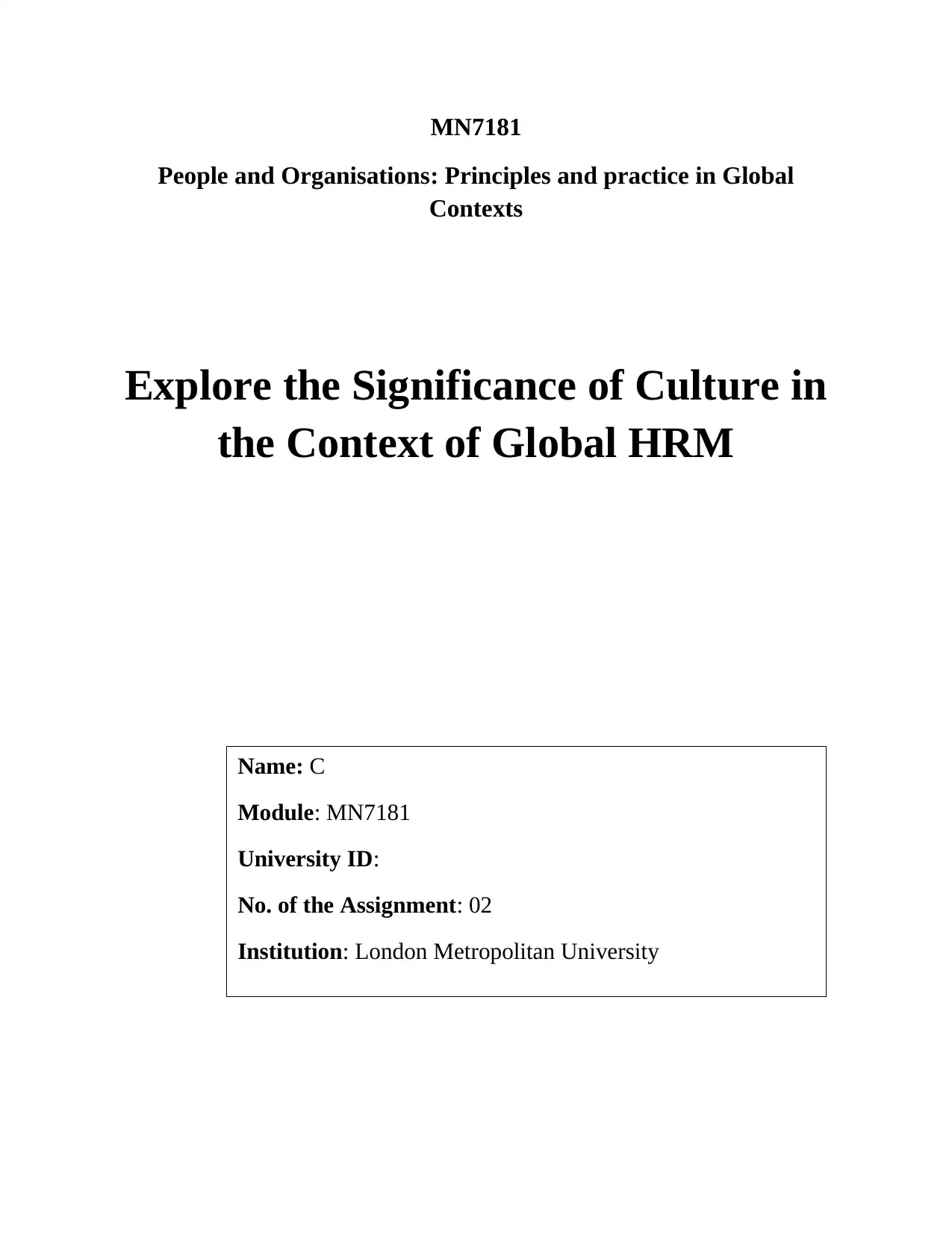
MN7181
People and Organisations: Principles and practice in Global
Contexts
Explore the Significance of Culture in
the Context of Global HRM
Name: C
Module: MN7181
University ID:
No. of the Assignment: 02
Institution: London Metropolitan University
People and Organisations: Principles and practice in Global
Contexts
Explore the Significance of Culture in
the Context of Global HRM
Name: C
Module: MN7181
University ID:
No. of the Assignment: 02
Institution: London Metropolitan University
Secure Best Marks with AI Grader
Need help grading? Try our AI Grader for instant feedback on your assignments.
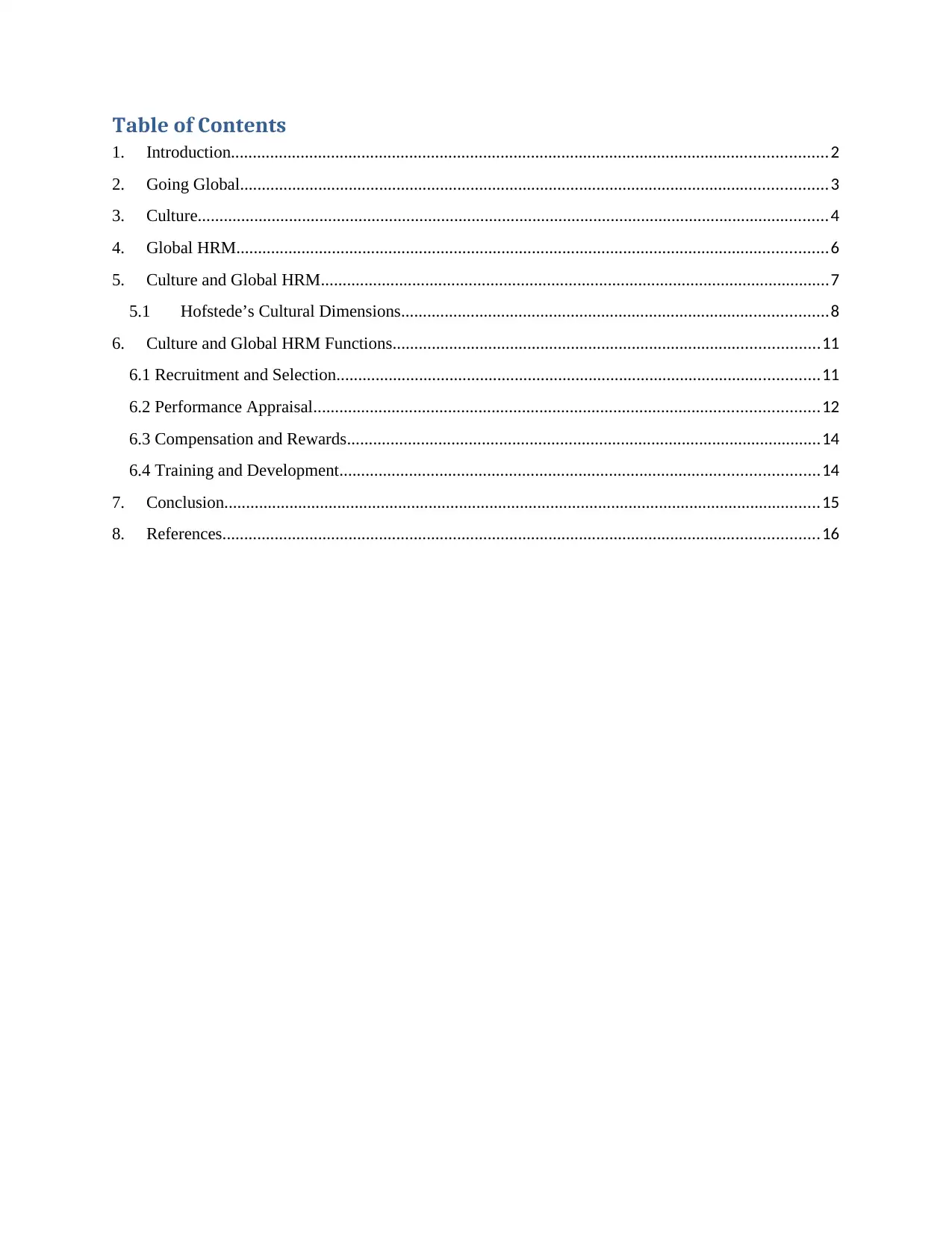
Table of Contents
1. Introduction.........................................................................................................................................2
2. Going Global.......................................................................................................................................3
3. Culture.................................................................................................................................................4
4. Global HRM........................................................................................................................................6
5. Culture and Global HRM.....................................................................................................................7
5.1 Hofstede’s Cultural Dimensions..................................................................................................8
6. Culture and Global HRM Functions..................................................................................................11
6.1 Recruitment and Selection...............................................................................................................11
6.2 Performance Appraisal....................................................................................................................12
6.3 Compensation and Rewards.............................................................................................................14
6.4 Training and Development..............................................................................................................14
7. Conclusion.........................................................................................................................................15
8. References.........................................................................................................................................16
1. Introduction.........................................................................................................................................2
2. Going Global.......................................................................................................................................3
3. Culture.................................................................................................................................................4
4. Global HRM........................................................................................................................................6
5. Culture and Global HRM.....................................................................................................................7
5.1 Hofstede’s Cultural Dimensions..................................................................................................8
6. Culture and Global HRM Functions..................................................................................................11
6.1 Recruitment and Selection...............................................................................................................11
6.2 Performance Appraisal....................................................................................................................12
6.3 Compensation and Rewards.............................................................................................................14
6.4 Training and Development..............................................................................................................14
7. Conclusion.........................................................................................................................................15
8. References.........................................................................................................................................16
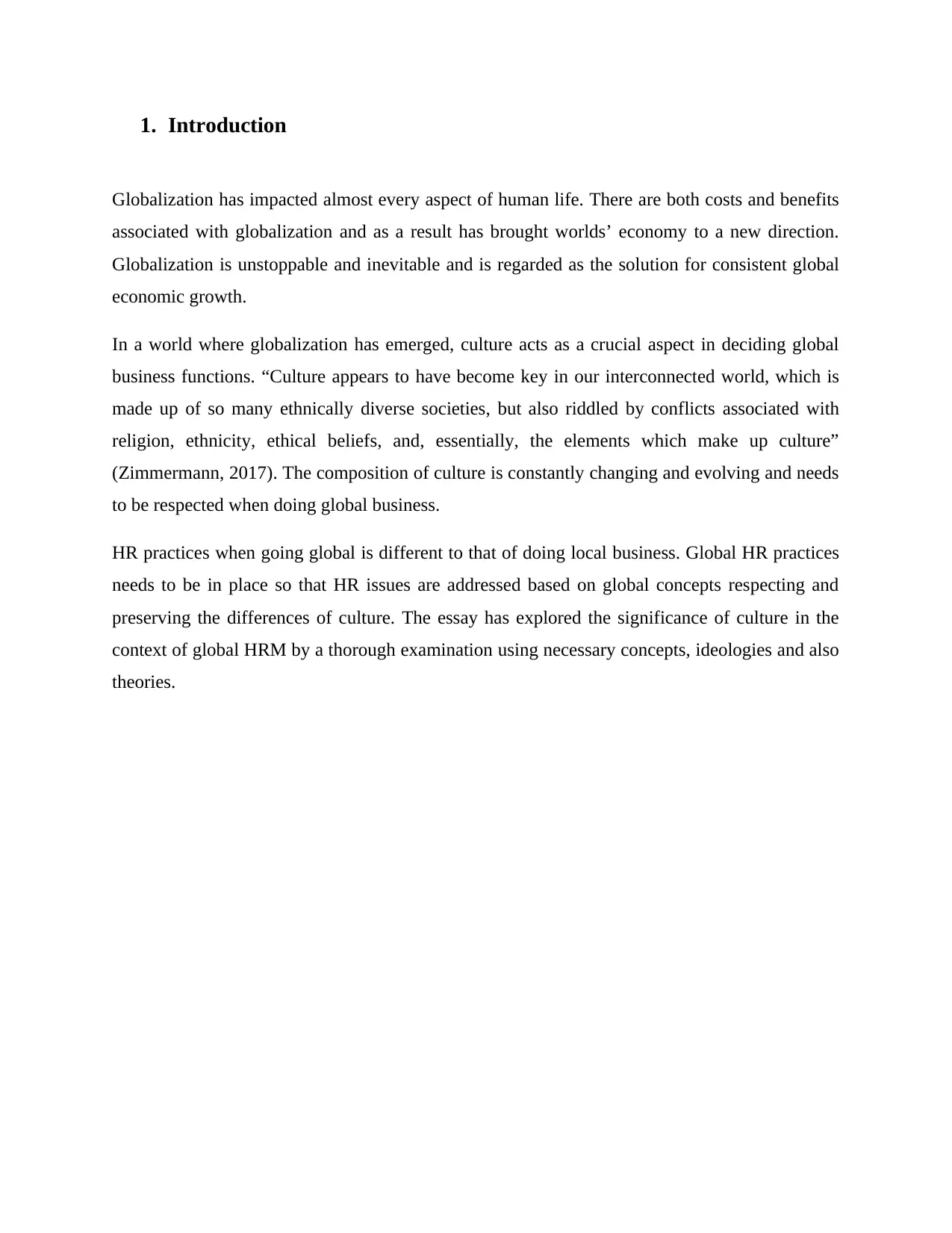
1. Introduction
Globalization has impacted almost every aspect of human life. There are both costs and benefits
associated with globalization and as a result has brought worlds’ economy to a new direction.
Globalization is unstoppable and inevitable and is regarded as the solution for consistent global
economic growth.
In a world where globalization has emerged, culture acts as a crucial aspect in deciding global
business functions. “Culture appears to have become key in our interconnected world, which is
made up of so many ethnically diverse societies, but also riddled by conflicts associated with
religion, ethnicity, ethical beliefs, and, essentially, the elements which make up culture”
(Zimmermann, 2017). The composition of culture is constantly changing and evolving and needs
to be respected when doing global business.
HR practices when going global is different to that of doing local business. Global HR practices
needs to be in place so that HR issues are addressed based on global concepts respecting and
preserving the differences of culture. The essay has explored the significance of culture in the
context of global HRM by a thorough examination using necessary concepts, ideologies and also
theories.
Globalization has impacted almost every aspect of human life. There are both costs and benefits
associated with globalization and as a result has brought worlds’ economy to a new direction.
Globalization is unstoppable and inevitable and is regarded as the solution for consistent global
economic growth.
In a world where globalization has emerged, culture acts as a crucial aspect in deciding global
business functions. “Culture appears to have become key in our interconnected world, which is
made up of so many ethnically diverse societies, but also riddled by conflicts associated with
religion, ethnicity, ethical beliefs, and, essentially, the elements which make up culture”
(Zimmermann, 2017). The composition of culture is constantly changing and evolving and needs
to be respected when doing global business.
HR practices when going global is different to that of doing local business. Global HR practices
needs to be in place so that HR issues are addressed based on global concepts respecting and
preserving the differences of culture. The essay has explored the significance of culture in the
context of global HRM by a thorough examination using necessary concepts, ideologies and also
theories.
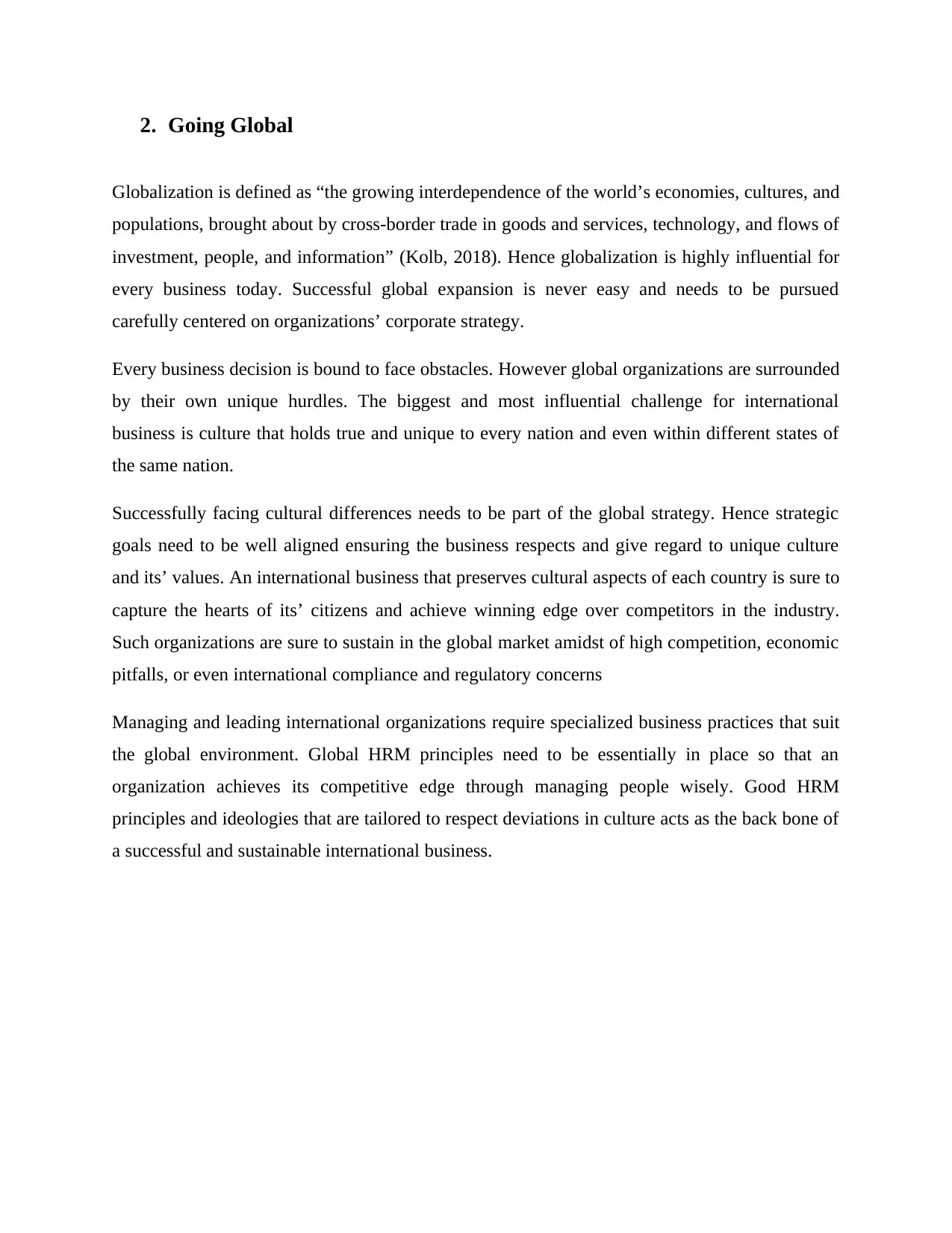
2. Going Global
Globalization is defined as “the growing interdependence of the world’s economies, cultures, and
populations, brought about by cross-border trade in goods and services, technology, and flows of
investment, people, and information” (Kolb, 2018). Hence globalization is highly influential for
every business today. Successful global expansion is never easy and needs to be pursued
carefully centered on organizations’ corporate strategy.
Every business decision is bound to face obstacles. However global organizations are surrounded
by their own unique hurdles. The biggest and most influential challenge for international
business is culture that holds true and unique to every nation and even within different states of
the same nation.
Successfully facing cultural differences needs to be part of the global strategy. Hence strategic
goals need to be well aligned ensuring the business respects and give regard to unique culture
and its’ values. An international business that preserves cultural aspects of each country is sure to
capture the hearts of its’ citizens and achieve winning edge over competitors in the industry.
Such organizations are sure to sustain in the global market amidst of high competition, economic
pitfalls, or even international compliance and regulatory concerns
Managing and leading international organizations require specialized business practices that suit
the global environment. Global HRM principles need to be essentially in place so that an
organization achieves its competitive edge through managing people wisely. Good HRM
principles and ideologies that are tailored to respect deviations in culture acts as the back bone of
a successful and sustainable international business.
Globalization is defined as “the growing interdependence of the world’s economies, cultures, and
populations, brought about by cross-border trade in goods and services, technology, and flows of
investment, people, and information” (Kolb, 2018). Hence globalization is highly influential for
every business today. Successful global expansion is never easy and needs to be pursued
carefully centered on organizations’ corporate strategy.
Every business decision is bound to face obstacles. However global organizations are surrounded
by their own unique hurdles. The biggest and most influential challenge for international
business is culture that holds true and unique to every nation and even within different states of
the same nation.
Successfully facing cultural differences needs to be part of the global strategy. Hence strategic
goals need to be well aligned ensuring the business respects and give regard to unique culture
and its’ values. An international business that preserves cultural aspects of each country is sure to
capture the hearts of its’ citizens and achieve winning edge over competitors in the industry.
Such organizations are sure to sustain in the global market amidst of high competition, economic
pitfalls, or even international compliance and regulatory concerns
Managing and leading international organizations require specialized business practices that suit
the global environment. Global HRM principles need to be essentially in place so that an
organization achieves its competitive edge through managing people wisely. Good HRM
principles and ideologies that are tailored to respect deviations in culture acts as the back bone of
a successful and sustainable international business.
Secure Best Marks with AI Grader
Need help grading? Try our AI Grader for instant feedback on your assignments.
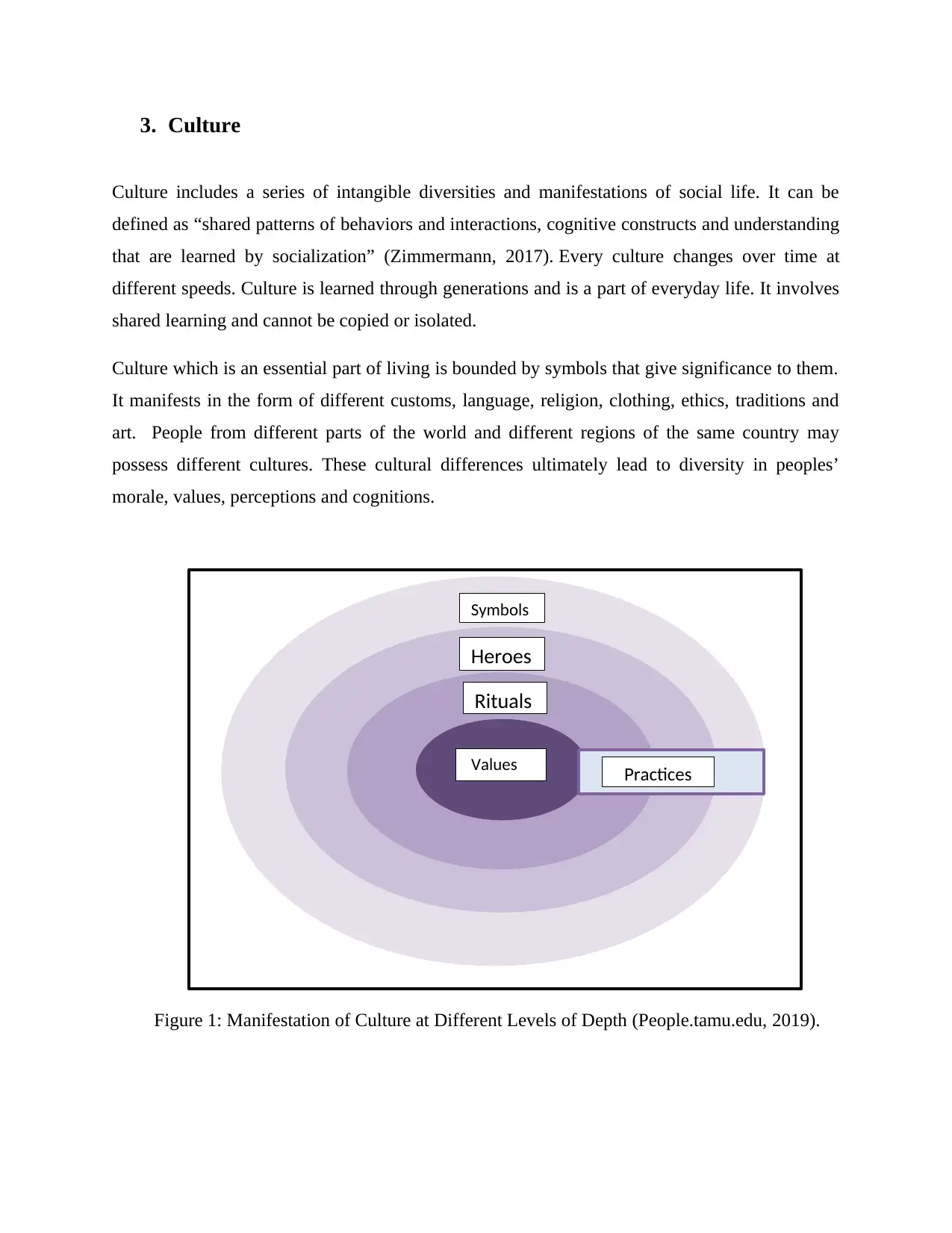
3. Culture
Culture includes a series of intangible diversities and manifestations of social life. It can be
defined as “shared patterns of behaviors and interactions, cognitive constructs and understanding
that are learned by socialization” (Zimmermann, 2017). Every culture changes over time at
different speeds. Culture is learned through generations and is a part of everyday life. It involves
shared learning and cannot be copied or isolated.
Culture which is an essential part of living is bounded by symbols that give significance to them.
It manifests in the form of different customs, language, religion, clothing, ethics, traditions and
art. People from different parts of the world and different regions of the same country may
possess different cultures. These cultural differences ultimately lead to diversity in peoples’
morale, values, perceptions and cognitions.
Figure 1: Manifestation of Culture at Different Levels of Depth (People.tamu.edu, 2019).
Symbols
Heroes
Rituals
Values Practices
Culture includes a series of intangible diversities and manifestations of social life. It can be
defined as “shared patterns of behaviors and interactions, cognitive constructs and understanding
that are learned by socialization” (Zimmermann, 2017). Every culture changes over time at
different speeds. Culture is learned through generations and is a part of everyday life. It involves
shared learning and cannot be copied or isolated.
Culture which is an essential part of living is bounded by symbols that give significance to them.
It manifests in the form of different customs, language, religion, clothing, ethics, traditions and
art. People from different parts of the world and different regions of the same country may
possess different cultures. These cultural differences ultimately lead to diversity in peoples’
morale, values, perceptions and cognitions.
Figure 1: Manifestation of Culture at Different Levels of Depth (People.tamu.edu, 2019).
Symbols
Heroes
Rituals
Values Practices
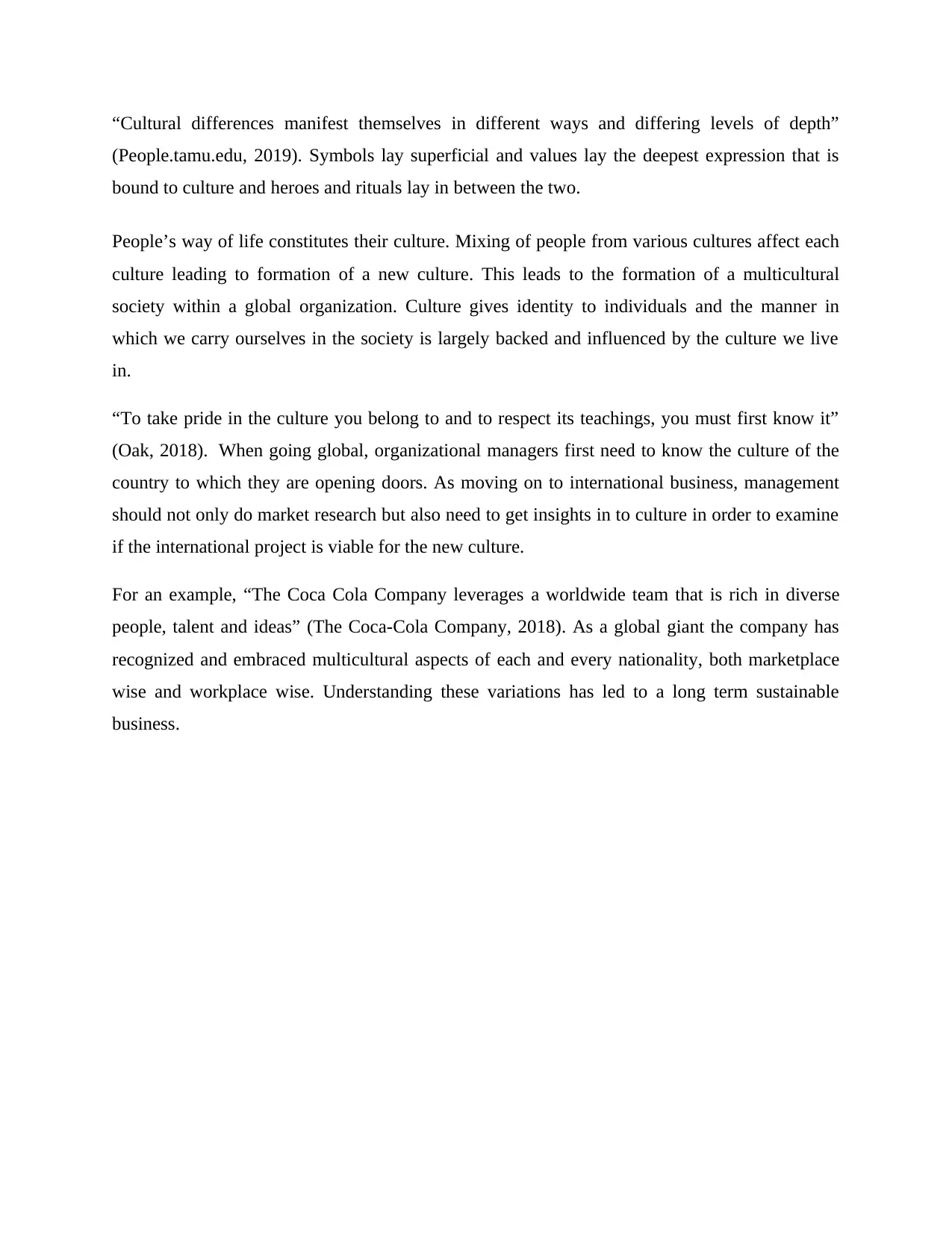
“Cultural differences manifest themselves in different ways and differing levels of depth”
(People.tamu.edu, 2019). Symbols lay superficial and values lay the deepest expression that is
bound to culture and heroes and rituals lay in between the two.
People’s way of life constitutes their culture. Mixing of people from various cultures affect each
culture leading to formation of a new culture. This leads to the formation of a multicultural
society within a global organization. Culture gives identity to individuals and the manner in
which we carry ourselves in the society is largely backed and influenced by the culture we live
in.
“To take pride in the culture you belong to and to respect its teachings, you must first know it”
(Oak, 2018). When going global, organizational managers first need to know the culture of the
country to which they are opening doors. As moving on to international business, management
should not only do market research but also need to get insights in to culture in order to examine
if the international project is viable for the new culture.
For an example, “The Coca Cola Company leverages a worldwide team that is rich in diverse
people, talent and ideas” (The Coca-Cola Company, 2018). As a global giant the company has
recognized and embraced multicultural aspects of each and every nationality, both marketplace
wise and workplace wise. Understanding these variations has led to a long term sustainable
business.
(People.tamu.edu, 2019). Symbols lay superficial and values lay the deepest expression that is
bound to culture and heroes and rituals lay in between the two.
People’s way of life constitutes their culture. Mixing of people from various cultures affect each
culture leading to formation of a new culture. This leads to the formation of a multicultural
society within a global organization. Culture gives identity to individuals and the manner in
which we carry ourselves in the society is largely backed and influenced by the culture we live
in.
“To take pride in the culture you belong to and to respect its teachings, you must first know it”
(Oak, 2018). When going global, organizational managers first need to know the culture of the
country to which they are opening doors. As moving on to international business, management
should not only do market research but also need to get insights in to culture in order to examine
if the international project is viable for the new culture.
For an example, “The Coca Cola Company leverages a worldwide team that is rich in diverse
people, talent and ideas” (The Coca-Cola Company, 2018). As a global giant the company has
recognized and embraced multicultural aspects of each and every nationality, both marketplace
wise and workplace wise. Understanding these variations has led to a long term sustainable
business.
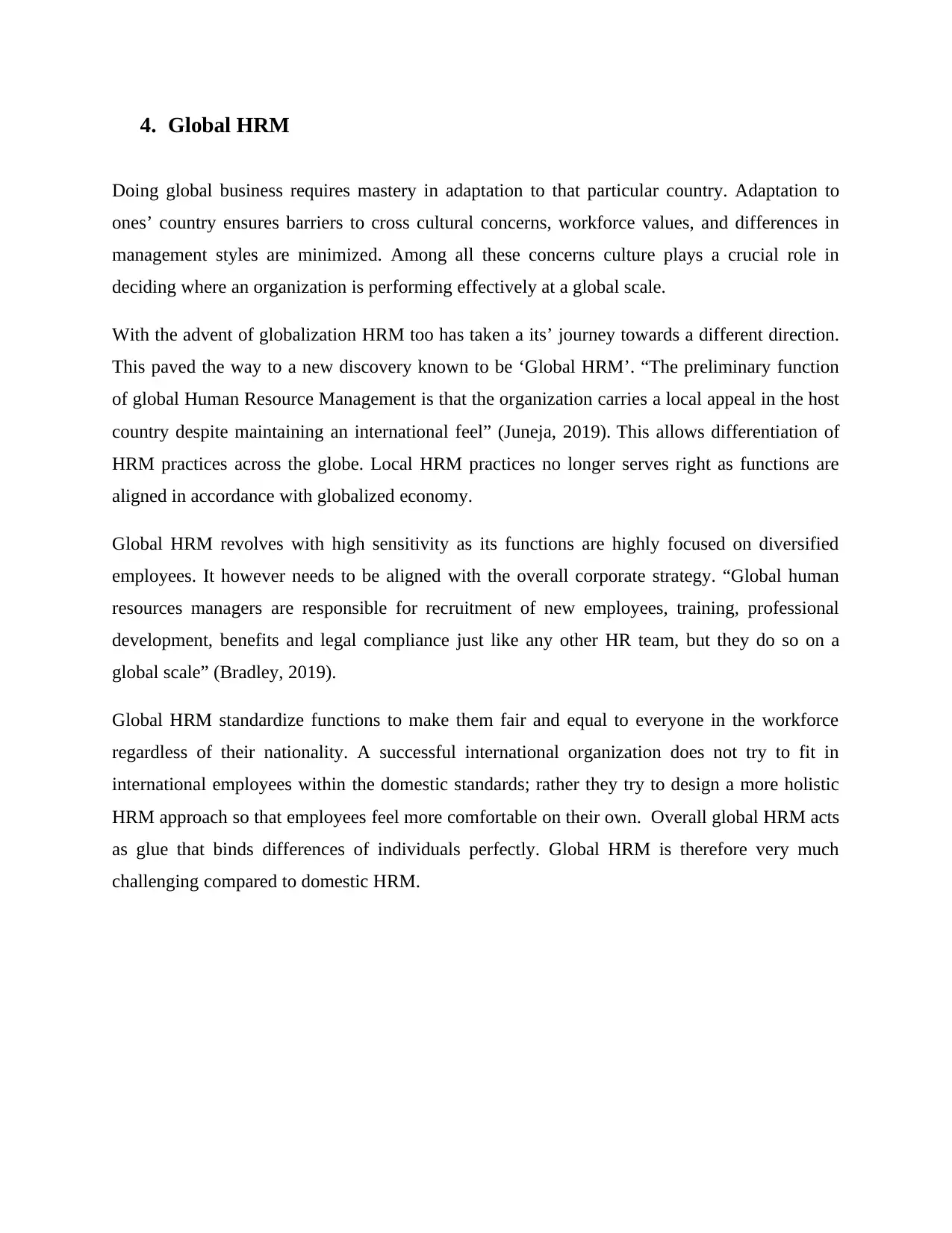
4. Global HRM
Doing global business requires mastery in adaptation to that particular country. Adaptation to
ones’ country ensures barriers to cross cultural concerns, workforce values, and differences in
management styles are minimized. Among all these concerns culture plays a crucial role in
deciding where an organization is performing effectively at a global scale.
With the advent of globalization HRM too has taken a its’ journey towards a different direction.
This paved the way to a new discovery known to be ‘Global HRM’. “The preliminary function
of global Human Resource Management is that the organization carries a local appeal in the host
country despite maintaining an international feel” (Juneja, 2019). This allows differentiation of
HRM practices across the globe. Local HRM practices no longer serves right as functions are
aligned in accordance with globalized economy.
Global HRM revolves with high sensitivity as its functions are highly focused on diversified
employees. It however needs to be aligned with the overall corporate strategy. “Global human
resources managers are responsible for recruitment of new employees, training, professional
development, benefits and legal compliance just like any other HR team, but they do so on a
global scale” (Bradley, 2019).
Global HRM standardize functions to make them fair and equal to everyone in the workforce
regardless of their nationality. A successful international organization does not try to fit in
international employees within the domestic standards; rather they try to design a more holistic
HRM approach so that employees feel more comfortable on their own. Overall global HRM acts
as glue that binds differences of individuals perfectly. Global HRM is therefore very much
challenging compared to domestic HRM.
Doing global business requires mastery in adaptation to that particular country. Adaptation to
ones’ country ensures barriers to cross cultural concerns, workforce values, and differences in
management styles are minimized. Among all these concerns culture plays a crucial role in
deciding where an organization is performing effectively at a global scale.
With the advent of globalization HRM too has taken a its’ journey towards a different direction.
This paved the way to a new discovery known to be ‘Global HRM’. “The preliminary function
of global Human Resource Management is that the organization carries a local appeal in the host
country despite maintaining an international feel” (Juneja, 2019). This allows differentiation of
HRM practices across the globe. Local HRM practices no longer serves right as functions are
aligned in accordance with globalized economy.
Global HRM revolves with high sensitivity as its functions are highly focused on diversified
employees. It however needs to be aligned with the overall corporate strategy. “Global human
resources managers are responsible for recruitment of new employees, training, professional
development, benefits and legal compliance just like any other HR team, but they do so on a
global scale” (Bradley, 2019).
Global HRM standardize functions to make them fair and equal to everyone in the workforce
regardless of their nationality. A successful international organization does not try to fit in
international employees within the domestic standards; rather they try to design a more holistic
HRM approach so that employees feel more comfortable on their own. Overall global HRM acts
as glue that binds differences of individuals perfectly. Global HRM is therefore very much
challenging compared to domestic HRM.
Paraphrase This Document
Need a fresh take? Get an instant paraphrase of this document with our AI Paraphraser
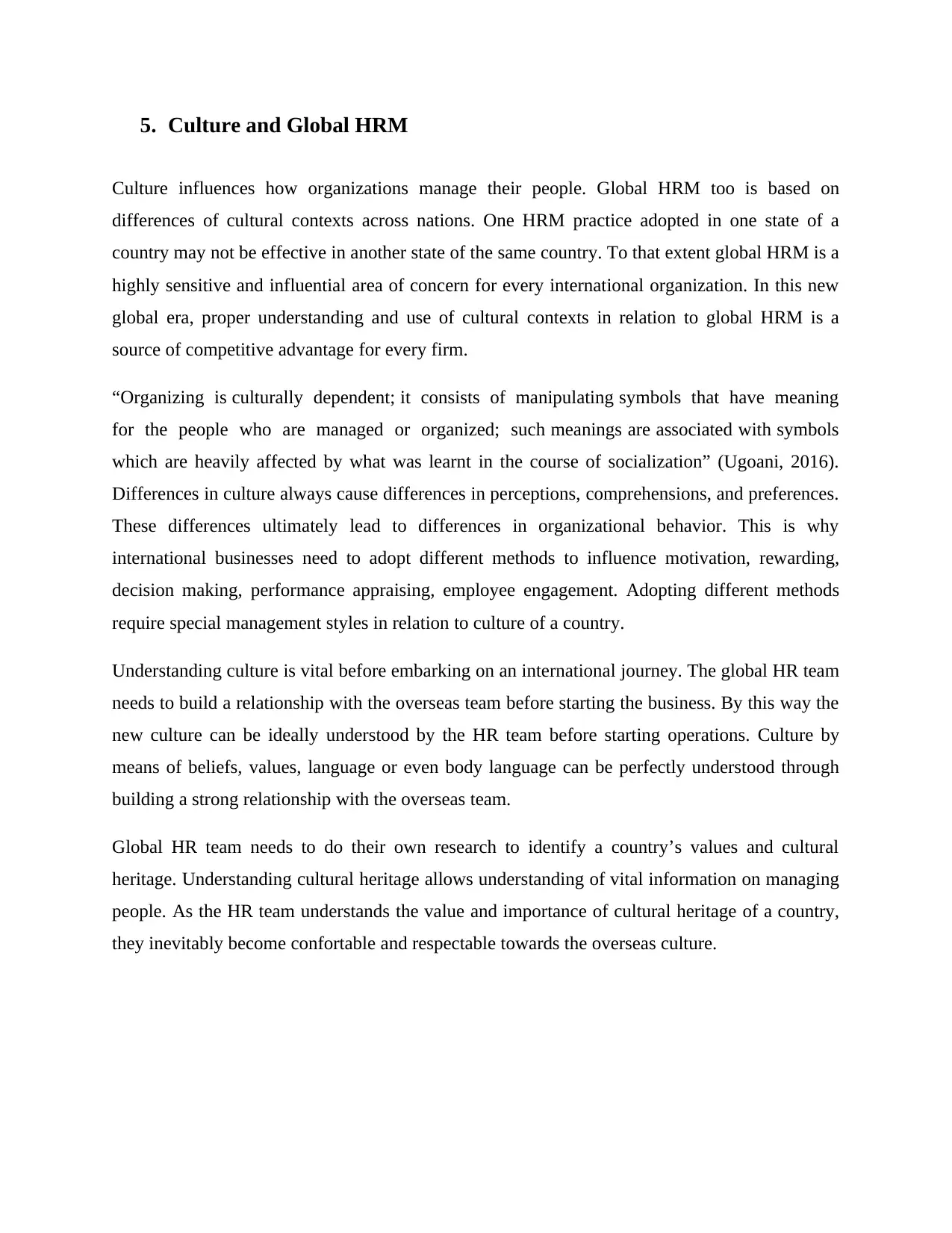
5. Culture and Global HRM
Culture influences how organizations manage their people. Global HRM too is based on
differences of cultural contexts across nations. One HRM practice adopted in one state of a
country may not be effective in another state of the same country. To that extent global HRM is a
highly sensitive and influential area of concern for every international organization. In this new
global era, proper understanding and use of cultural contexts in relation to global HRM is a
source of competitive advantage for every firm.
“Organizing is culturally dependent; it consists of manipulating symbols that have meaning
for the people who are managed or organized; such meanings are associated with symbols
which are heavily affected by what was learnt in the course of socialization” (Ugoani, 2016).
Differences in culture always cause differences in perceptions, comprehensions, and preferences.
These differences ultimately lead to differences in organizational behavior. This is why
international businesses need to adopt different methods to influence motivation, rewarding,
decision making, performance appraising, employee engagement. Adopting different methods
require special management styles in relation to culture of a country.
Understanding culture is vital before embarking on an international journey. The global HR team
needs to build a relationship with the overseas team before starting the business. By this way the
new culture can be ideally understood by the HR team before starting operations. Culture by
means of beliefs, values, language or even body language can be perfectly understood through
building a strong relationship with the overseas team.
Global HR team needs to do their own research to identify a country’s values and cultural
heritage. Understanding cultural heritage allows understanding of vital information on managing
people. As the HR team understands the value and importance of cultural heritage of a country,
they inevitably become confortable and respectable towards the overseas culture.
Culture influences how organizations manage their people. Global HRM too is based on
differences of cultural contexts across nations. One HRM practice adopted in one state of a
country may not be effective in another state of the same country. To that extent global HRM is a
highly sensitive and influential area of concern for every international organization. In this new
global era, proper understanding and use of cultural contexts in relation to global HRM is a
source of competitive advantage for every firm.
“Organizing is culturally dependent; it consists of manipulating symbols that have meaning
for the people who are managed or organized; such meanings are associated with symbols
which are heavily affected by what was learnt in the course of socialization” (Ugoani, 2016).
Differences in culture always cause differences in perceptions, comprehensions, and preferences.
These differences ultimately lead to differences in organizational behavior. This is why
international businesses need to adopt different methods to influence motivation, rewarding,
decision making, performance appraising, employee engagement. Adopting different methods
require special management styles in relation to culture of a country.
Understanding culture is vital before embarking on an international journey. The global HR team
needs to build a relationship with the overseas team before starting the business. By this way the
new culture can be ideally understood by the HR team before starting operations. Culture by
means of beliefs, values, language or even body language can be perfectly understood through
building a strong relationship with the overseas team.
Global HR team needs to do their own research to identify a country’s values and cultural
heritage. Understanding cultural heritage allows understanding of vital information on managing
people. As the HR team understands the value and importance of cultural heritage of a country,
they inevitably become confortable and respectable towards the overseas culture.
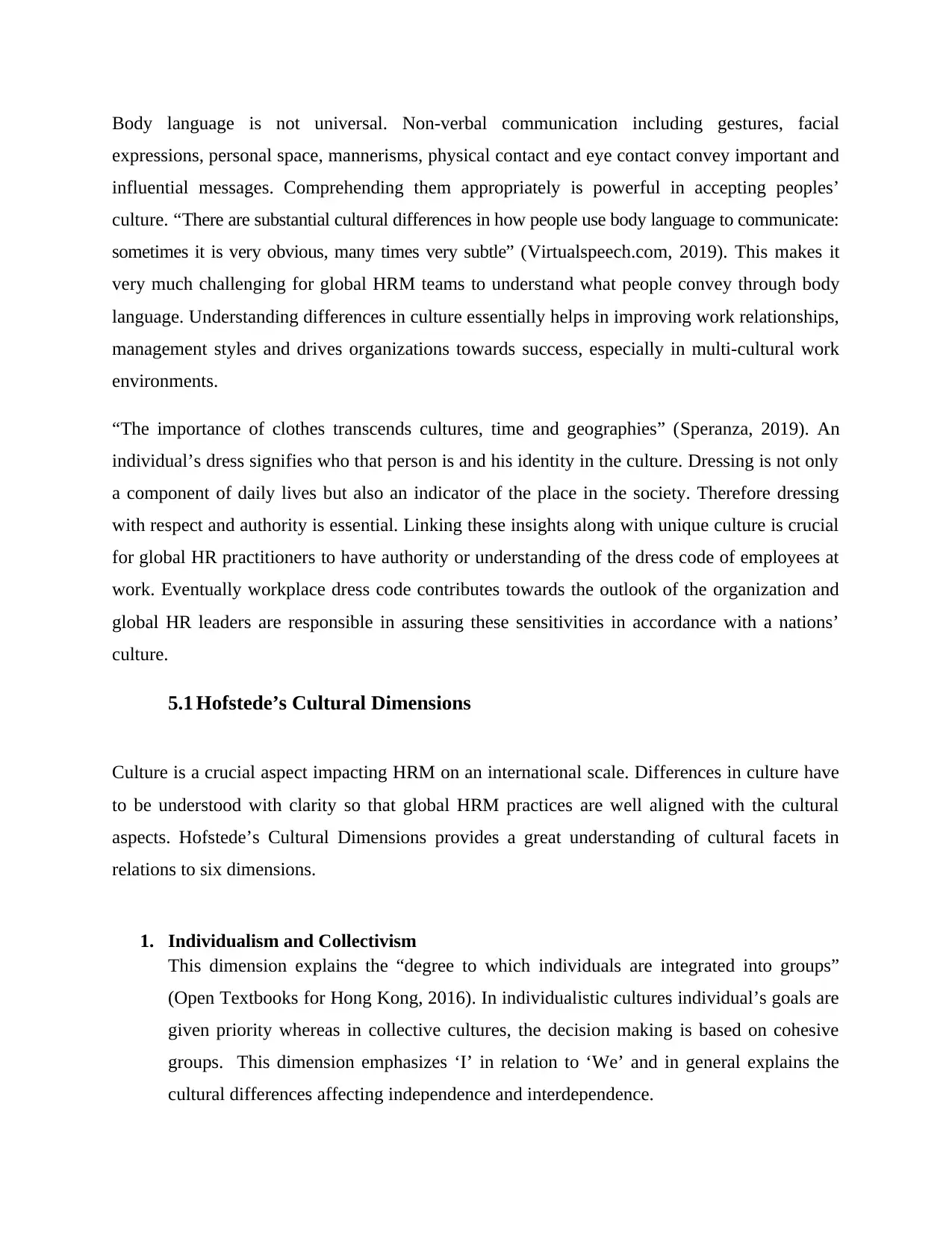
Body language is not universal. Non-verbal communication including gestures, facial
expressions, personal space, mannerisms, physical contact and eye contact convey important and
influential messages. Comprehending them appropriately is powerful in accepting peoples’
culture. “There are substantial cultural differences in how people use body language to communicate:
sometimes it is very obvious, many times very subtle” (Virtualspeech.com, 2019). This makes it
very much challenging for global HRM teams to understand what people convey through body
language. Understanding differences in culture essentially helps in improving work relationships,
management styles and drives organizations towards success, especially in multi-cultural work
environments.
“The importance of clothes transcends cultures, time and geographies” (Speranza, 2019). An
individual’s dress signifies who that person is and his identity in the culture. Dressing is not only
a component of daily lives but also an indicator of the place in the society. Therefore dressing
with respect and authority is essential. Linking these insights along with unique culture is crucial
for global HR practitioners to have authority or understanding of the dress code of employees at
work. Eventually workplace dress code contributes towards the outlook of the organization and
global HR leaders are responsible in assuring these sensitivities in accordance with a nations’
culture.
5.1 Hofstede’s Cultural Dimensions
Culture is a crucial aspect impacting HRM on an international scale. Differences in culture have
to be understood with clarity so that global HRM practices are well aligned with the cultural
aspects. Hofstede’s Cultural Dimensions provides a great understanding of cultural facets in
relations to six dimensions.
1. Individualism and Collectivism
This dimension explains the “degree to which individuals are integrated into groups”
(Open Textbooks for Hong Kong, 2016). In individualistic cultures individual’s goals are
given priority whereas in collective cultures, the decision making is based on cohesive
groups. This dimension emphasizes ‘I’ in relation to ‘We’ and in general explains the
cultural differences affecting independence and interdependence.
expressions, personal space, mannerisms, physical contact and eye contact convey important and
influential messages. Comprehending them appropriately is powerful in accepting peoples’
culture. “There are substantial cultural differences in how people use body language to communicate:
sometimes it is very obvious, many times very subtle” (Virtualspeech.com, 2019). This makes it
very much challenging for global HRM teams to understand what people convey through body
language. Understanding differences in culture essentially helps in improving work relationships,
management styles and drives organizations towards success, especially in multi-cultural work
environments.
“The importance of clothes transcends cultures, time and geographies” (Speranza, 2019). An
individual’s dress signifies who that person is and his identity in the culture. Dressing is not only
a component of daily lives but also an indicator of the place in the society. Therefore dressing
with respect and authority is essential. Linking these insights along with unique culture is crucial
for global HR practitioners to have authority or understanding of the dress code of employees at
work. Eventually workplace dress code contributes towards the outlook of the organization and
global HR leaders are responsible in assuring these sensitivities in accordance with a nations’
culture.
5.1 Hofstede’s Cultural Dimensions
Culture is a crucial aspect impacting HRM on an international scale. Differences in culture have
to be understood with clarity so that global HRM practices are well aligned with the cultural
aspects. Hofstede’s Cultural Dimensions provides a great understanding of cultural facets in
relations to six dimensions.
1. Individualism and Collectivism
This dimension explains the “degree to which individuals are integrated into groups”
(Open Textbooks for Hong Kong, 2016). In individualistic cultures individual’s goals are
given priority whereas in collective cultures, the decision making is based on cohesive
groups. This dimension emphasizes ‘I’ in relation to ‘We’ and in general explains the
cultural differences affecting independence and interdependence.
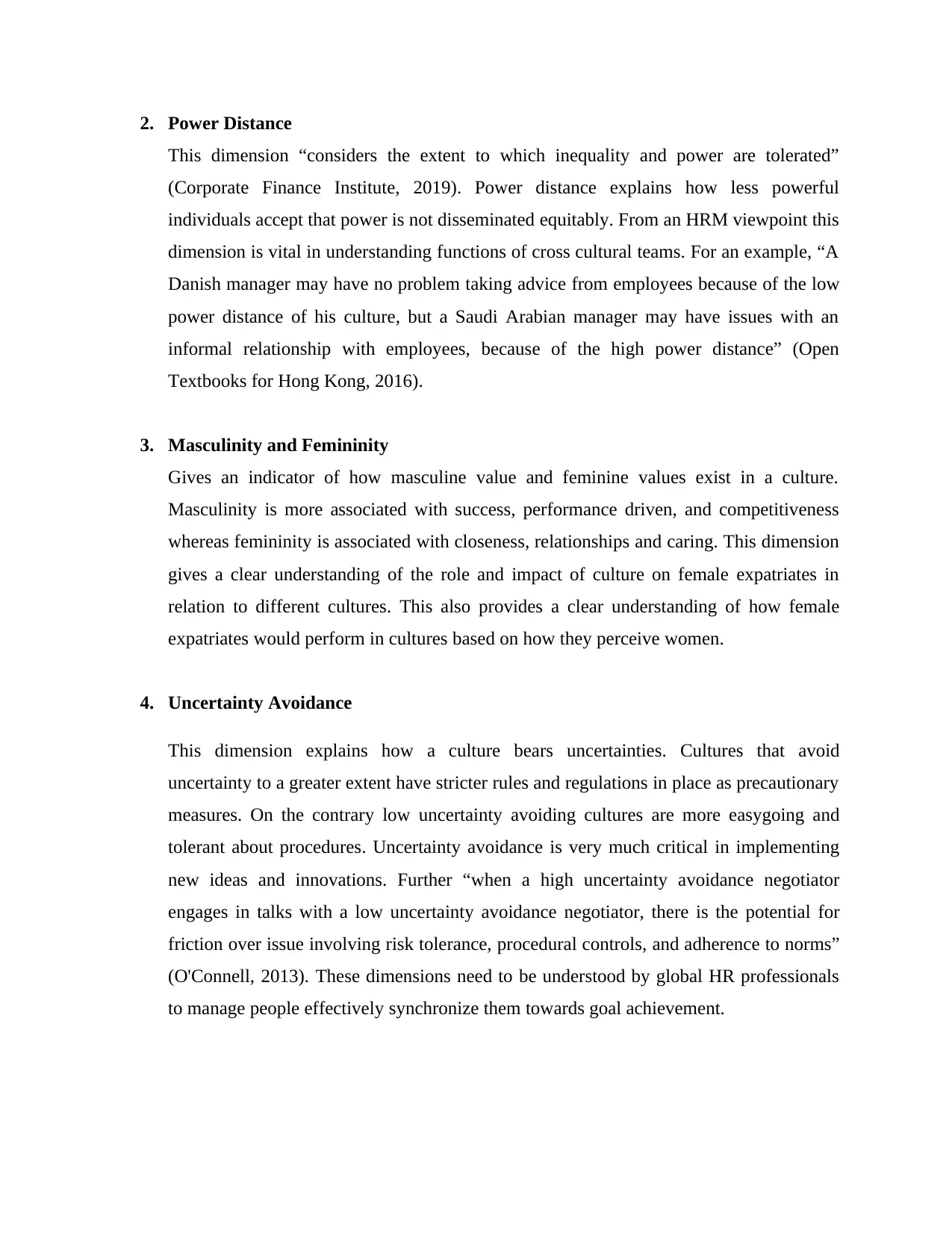
2. Power Distance
This dimension “considers the extent to which inequality and power are tolerated”
(Corporate Finance Institute, 2019). Power distance explains how less powerful
individuals accept that power is not disseminated equitably. From an HRM viewpoint this
dimension is vital in understanding functions of cross cultural teams. For an example, “A
Danish manager may have no problem taking advice from employees because of the low
power distance of his culture, but a Saudi Arabian manager may have issues with an
informal relationship with employees, because of the high power distance” (Open
Textbooks for Hong Kong, 2016).
3. Masculinity and Femininity
Gives an indicator of how masculine value and feminine values exist in a culture.
Masculinity is more associated with success, performance driven, and competitiveness
whereas femininity is associated with closeness, relationships and caring. This dimension
gives a clear understanding of the role and impact of culture on female expatriates in
relation to different cultures. This also provides a clear understanding of how female
expatriates would perform in cultures based on how they perceive women.
4. Uncertainty Avoidance
This dimension explains how a culture bears uncertainties. Cultures that avoid
uncertainty to a greater extent have stricter rules and regulations in place as precautionary
measures. On the contrary low uncertainty avoiding cultures are more easygoing and
tolerant about procedures. Uncertainty avoidance is very much critical in implementing
new ideas and innovations. Further “when a high uncertainty avoidance negotiator
engages in talks with a low uncertainty avoidance negotiator, there is the potential for
friction over issue involving risk tolerance, procedural controls, and adherence to norms”
(O'Connell, 2013). These dimensions need to be understood by global HR professionals
to manage people effectively synchronize them towards goal achievement.
This dimension “considers the extent to which inequality and power are tolerated”
(Corporate Finance Institute, 2019). Power distance explains how less powerful
individuals accept that power is not disseminated equitably. From an HRM viewpoint this
dimension is vital in understanding functions of cross cultural teams. For an example, “A
Danish manager may have no problem taking advice from employees because of the low
power distance of his culture, but a Saudi Arabian manager may have issues with an
informal relationship with employees, because of the high power distance” (Open
Textbooks for Hong Kong, 2016).
3. Masculinity and Femininity
Gives an indicator of how masculine value and feminine values exist in a culture.
Masculinity is more associated with success, performance driven, and competitiveness
whereas femininity is associated with closeness, relationships and caring. This dimension
gives a clear understanding of the role and impact of culture on female expatriates in
relation to different cultures. This also provides a clear understanding of how female
expatriates would perform in cultures based on how they perceive women.
4. Uncertainty Avoidance
This dimension explains how a culture bears uncertainties. Cultures that avoid
uncertainty to a greater extent have stricter rules and regulations in place as precautionary
measures. On the contrary low uncertainty avoiding cultures are more easygoing and
tolerant about procedures. Uncertainty avoidance is very much critical in implementing
new ideas and innovations. Further “when a high uncertainty avoidance negotiator
engages in talks with a low uncertainty avoidance negotiator, there is the potential for
friction over issue involving risk tolerance, procedural controls, and adherence to norms”
(O'Connell, 2013). These dimensions need to be understood by global HR professionals
to manage people effectively synchronize them towards goal achievement.
Secure Best Marks with AI Grader
Need help grading? Try our AI Grader for instant feedback on your assignments.
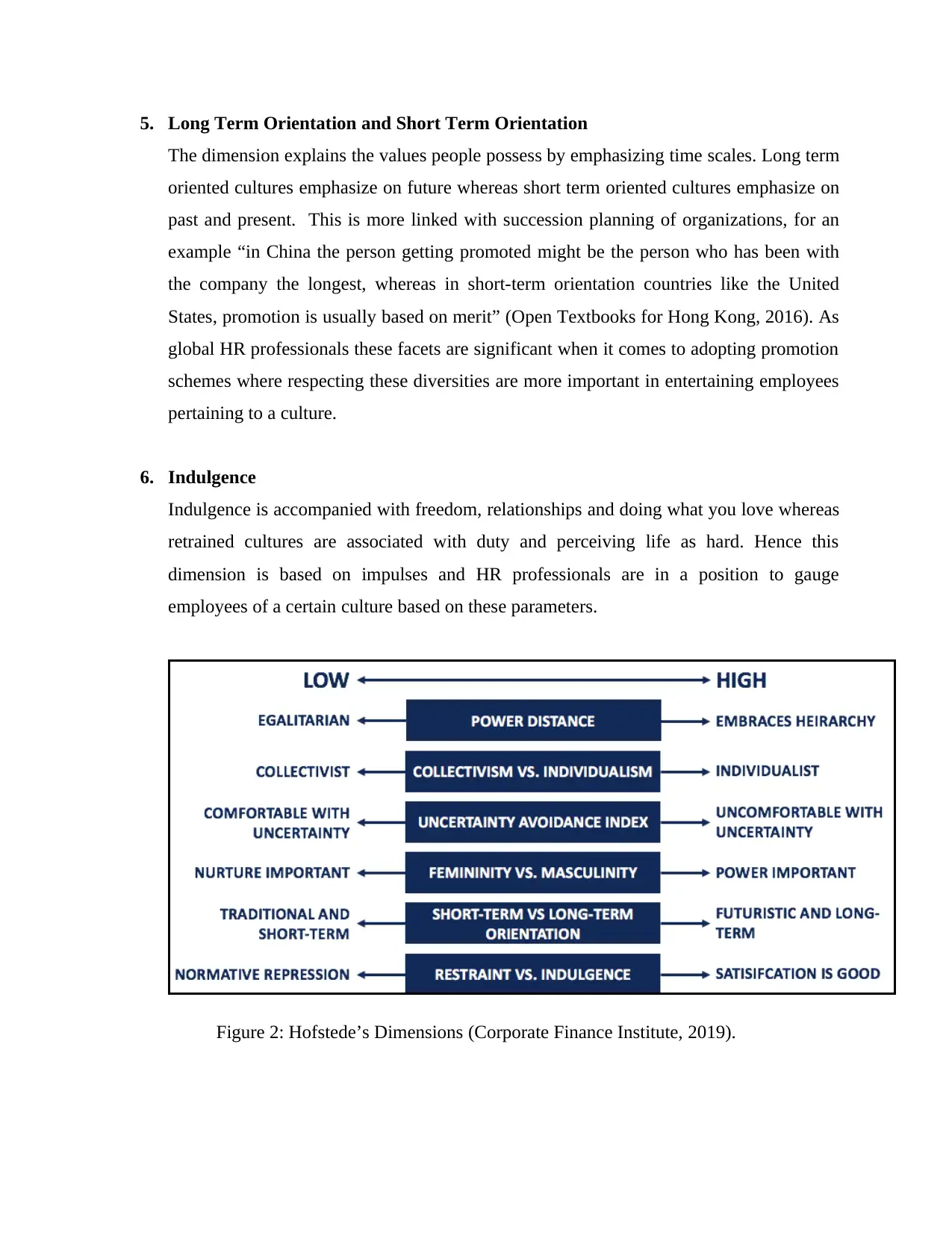
5. Long Term Orientation and Short Term Orientation
The dimension explains the values people possess by emphasizing time scales. Long term
oriented cultures emphasize on future whereas short term oriented cultures emphasize on
past and present. This is more linked with succession planning of organizations, for an
example “in China the person getting promoted might be the person who has been with
the company the longest, whereas in short-term orientation countries like the United
States, promotion is usually based on merit” (Open Textbooks for Hong Kong, 2016). As
global HR professionals these facets are significant when it comes to adopting promotion
schemes where respecting these diversities are more important in entertaining employees
pertaining to a culture.
6. Indulgence
Indulgence is accompanied with freedom, relationships and doing what you love whereas
retrained cultures are associated with duty and perceiving life as hard. Hence this
dimension is based on impulses and HR professionals are in a position to gauge
employees of a certain culture based on these parameters.
Figure 2: Hofstede’s Dimensions (Corporate Finance Institute, 2019).
The dimension explains the values people possess by emphasizing time scales. Long term
oriented cultures emphasize on future whereas short term oriented cultures emphasize on
past and present. This is more linked with succession planning of organizations, for an
example “in China the person getting promoted might be the person who has been with
the company the longest, whereas in short-term orientation countries like the United
States, promotion is usually based on merit” (Open Textbooks for Hong Kong, 2016). As
global HR professionals these facets are significant when it comes to adopting promotion
schemes where respecting these diversities are more important in entertaining employees
pertaining to a culture.
6. Indulgence
Indulgence is accompanied with freedom, relationships and doing what you love whereas
retrained cultures are associated with duty and perceiving life as hard. Hence this
dimension is based on impulses and HR professionals are in a position to gauge
employees of a certain culture based on these parameters.
Figure 2: Hofstede’s Dimensions (Corporate Finance Institute, 2019).
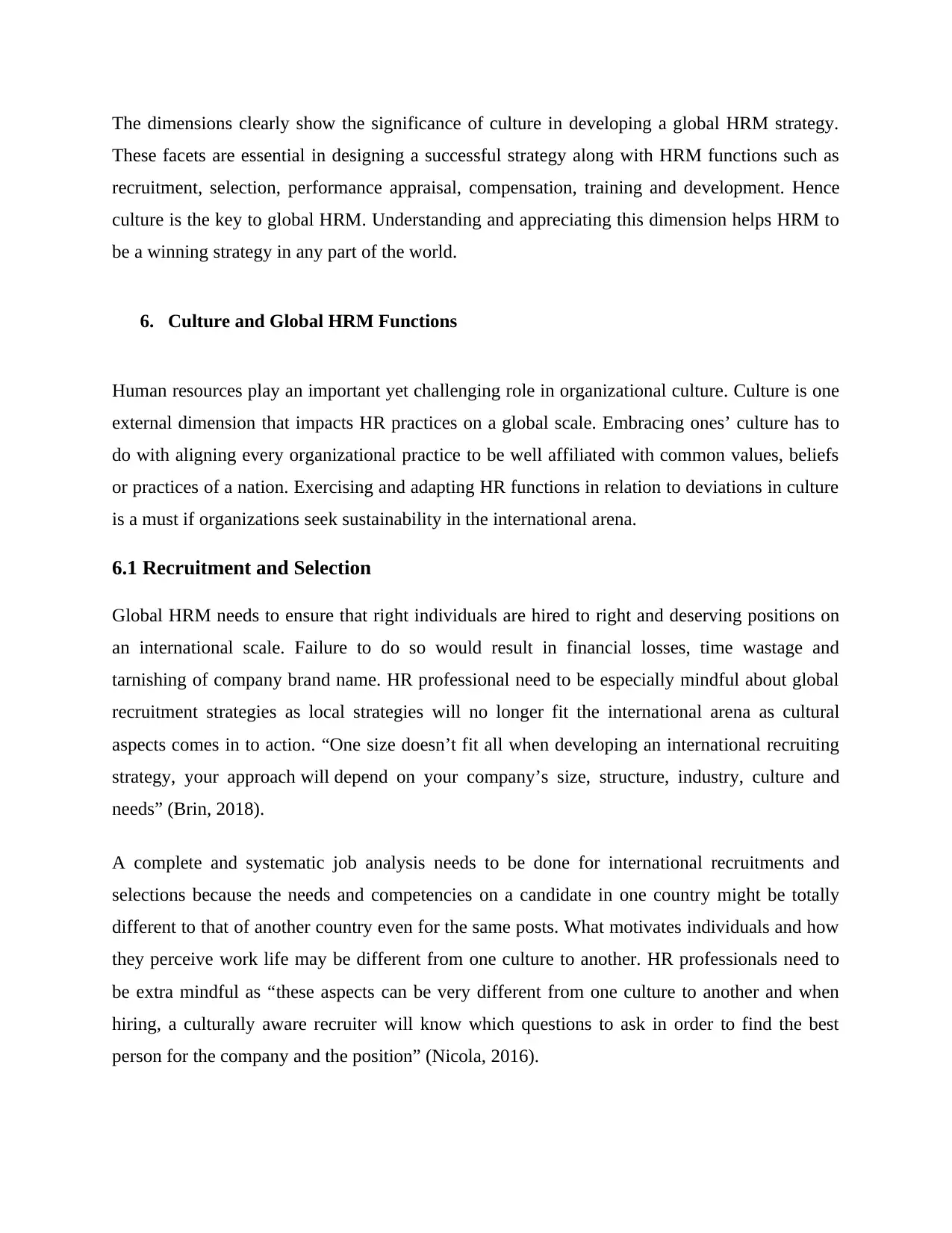
The dimensions clearly show the significance of culture in developing a global HRM strategy.
These facets are essential in designing a successful strategy along with HRM functions such as
recruitment, selection, performance appraisal, compensation, training and development. Hence
culture is the key to global HRM. Understanding and appreciating this dimension helps HRM to
be a winning strategy in any part of the world.
6. Culture and Global HRM Functions
Human resources play an important yet challenging role in organizational culture. Culture is one
external dimension that impacts HR practices on a global scale. Embracing ones’ culture has to
do with aligning every organizational practice to be well affiliated with common values, beliefs
or practices of a nation. Exercising and adapting HR functions in relation to deviations in culture
is a must if organizations seek sustainability in the international arena.
6.1 Recruitment and Selection
Global HRM needs to ensure that right individuals are hired to right and deserving positions on
an international scale. Failure to do so would result in financial losses, time wastage and
tarnishing of company brand name. HR professional need to be especially mindful about global
recruitment strategies as local strategies will no longer fit the international arena as cultural
aspects comes in to action. “One size doesn’t fit all when developing an international recruiting
strategy, your approach will depend on your company’s size, structure, industry, culture and
needs” (Brin, 2018).
A complete and systematic job analysis needs to be done for international recruitments and
selections because the needs and competencies on a candidate in one country might be totally
different to that of another country even for the same posts. What motivates individuals and how
they perceive work life may be different from one culture to another. HR professionals need to
be extra mindful as “these aspects can be very different from one culture to another and when
hiring, a culturally aware recruiter will know which questions to ask in order to find the best
person for the company and the position” (Nicola, 2016).
These facets are essential in designing a successful strategy along with HRM functions such as
recruitment, selection, performance appraisal, compensation, training and development. Hence
culture is the key to global HRM. Understanding and appreciating this dimension helps HRM to
be a winning strategy in any part of the world.
6. Culture and Global HRM Functions
Human resources play an important yet challenging role in organizational culture. Culture is one
external dimension that impacts HR practices on a global scale. Embracing ones’ culture has to
do with aligning every organizational practice to be well affiliated with common values, beliefs
or practices of a nation. Exercising and adapting HR functions in relation to deviations in culture
is a must if organizations seek sustainability in the international arena.
6.1 Recruitment and Selection
Global HRM needs to ensure that right individuals are hired to right and deserving positions on
an international scale. Failure to do so would result in financial losses, time wastage and
tarnishing of company brand name. HR professional need to be especially mindful about global
recruitment strategies as local strategies will no longer fit the international arena as cultural
aspects comes in to action. “One size doesn’t fit all when developing an international recruiting
strategy, your approach will depend on your company’s size, structure, industry, culture and
needs” (Brin, 2018).
A complete and systematic job analysis needs to be done for international recruitments and
selections because the needs and competencies on a candidate in one country might be totally
different to that of another country even for the same posts. What motivates individuals and how
they perceive work life may be different from one culture to another. HR professionals need to
be extra mindful as “these aspects can be very different from one culture to another and when
hiring, a culturally aware recruiter will know which questions to ask in order to find the best
person for the company and the position” (Nicola, 2016).
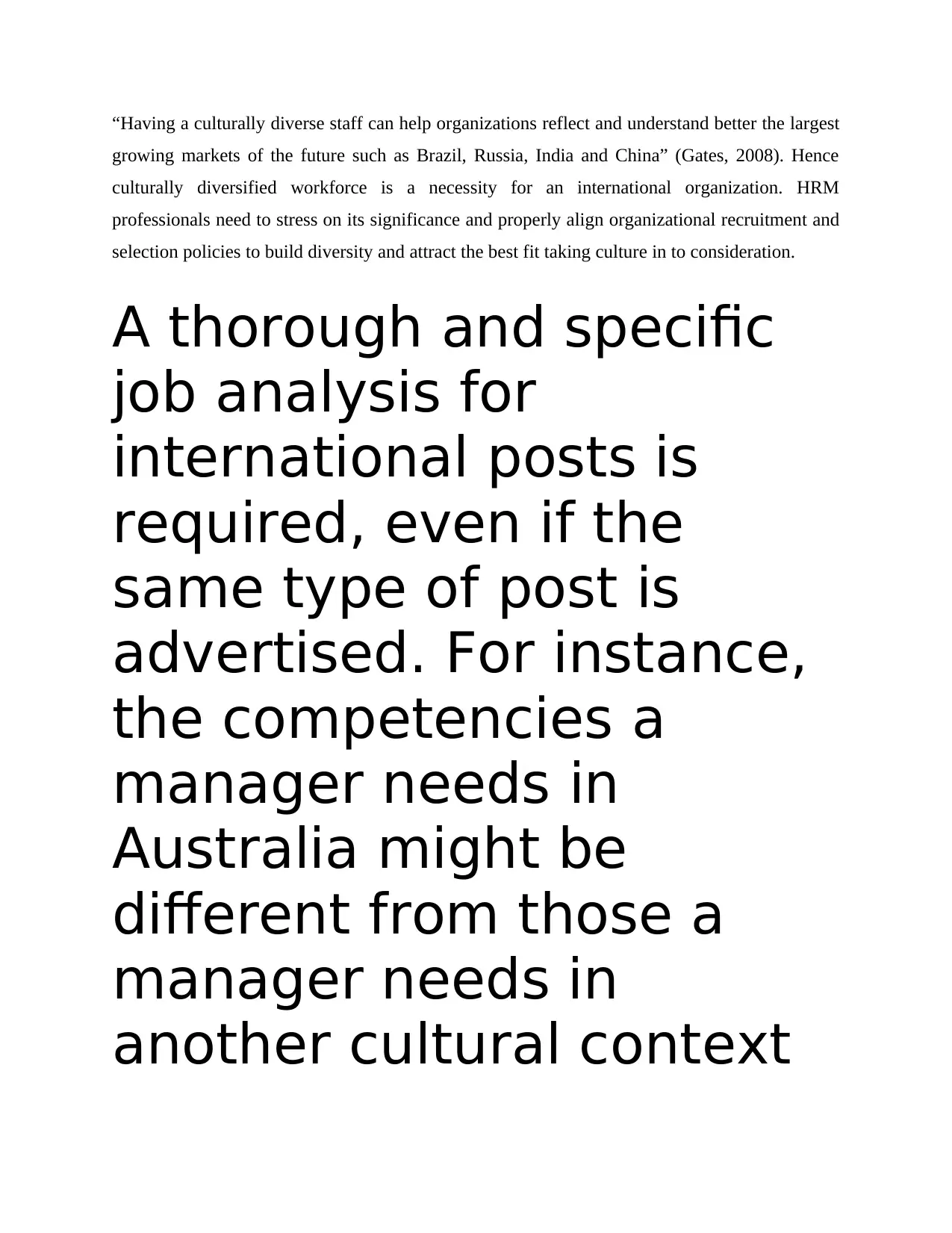
“Having a culturally diverse staff can help organizations reflect and understand better the largest
growing markets of the future such as Brazil, Russia, India and China” (Gates, 2008). Hence
culturally diversified workforce is a necessity for an international organization. HRM
professionals need to stress on its significance and properly align organizational recruitment and
selection policies to build diversity and attract the best fit taking culture in to consideration.
A thorough and specific
job analysis for
international posts is
required, even if the
same type of post is
advertised. For instance,
the competencies a
manager needs in
Australia might be
different from those a
manager needs in
another cultural context
growing markets of the future such as Brazil, Russia, India and China” (Gates, 2008). Hence
culturally diversified workforce is a necessity for an international organization. HRM
professionals need to stress on its significance and properly align organizational recruitment and
selection policies to build diversity and attract the best fit taking culture in to consideration.
A thorough and specific
job analysis for
international posts is
required, even if the
same type of post is
advertised. For instance,
the competencies a
manager needs in
Australia might be
different from those a
manager needs in
another cultural context
Paraphrase This Document
Need a fresh take? Get an instant paraphrase of this document with our AI Paraphraser
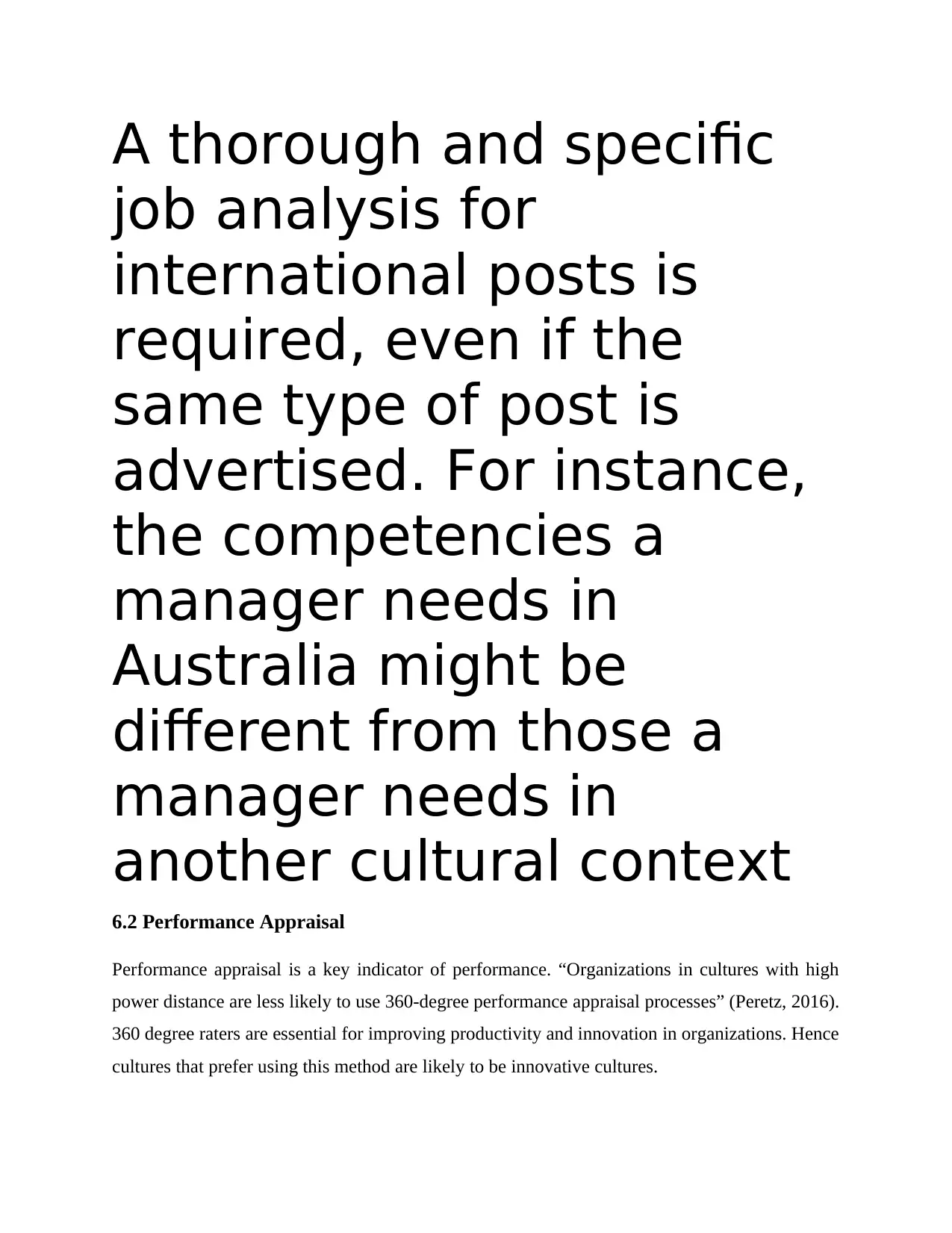
A thorough and specific
job analysis for
international posts is
required, even if the
same type of post is
advertised. For instance,
the competencies a
manager needs in
Australia might be
different from those a
manager needs in
another cultural context
6.2 Performance Appraisal
Performance appraisal is a key indicator of performance. “Organizations in cultures with high
power distance are less likely to use 360-degree performance appraisal processes” (Peretz, 2016).
360 degree raters are essential for improving productivity and innovation in organizations. Hence
cultures that prefer using this method are likely to be innovative cultures.
job analysis for
international posts is
required, even if the
same type of post is
advertised. For instance,
the competencies a
manager needs in
Australia might be
different from those a
manager needs in
another cultural context
6.2 Performance Appraisal
Performance appraisal is a key indicator of performance. “Organizations in cultures with high
power distance are less likely to use 360-degree performance appraisal processes” (Peretz, 2016).
360 degree raters are essential for improving productivity and innovation in organizations. Hence
cultures that prefer using this method are likely to be innovative cultures.
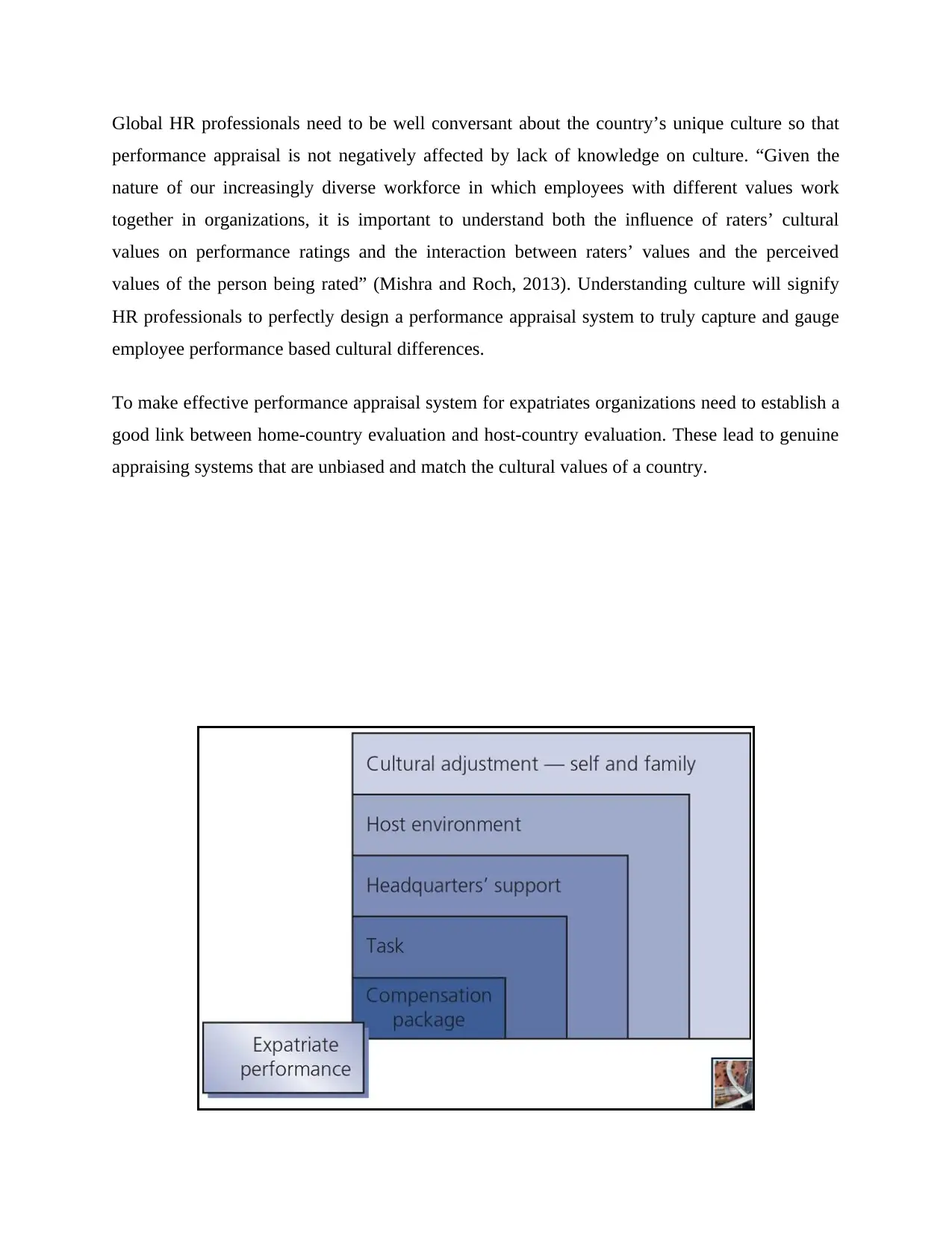
Global HR professionals need to be well conversant about the country’s unique culture so that
performance appraisal is not negatively affected by lack of knowledge on culture. “Given the
nature of our increasingly diverse workforce in which employees with different values work
together in organizations, it is important to understand both the influence of raters’ cultural
values on performance ratings and the interaction between raters’ values and the perceived
values of the person being rated” (Mishra and Roch, 2013). Understanding culture will signify
HR professionals to perfectly design a performance appraisal system to truly capture and gauge
employee performance based cultural differences.
To make effective performance appraisal system for expatriates organizations need to establish a
good link between home-country evaluation and host-country evaluation. These lead to genuine
appraising systems that are unbiased and match the cultural values of a country.
performance appraisal is not negatively affected by lack of knowledge on culture. “Given the
nature of our increasingly diverse workforce in which employees with different values work
together in organizations, it is important to understand both the influence of raters’ cultural
values on performance ratings and the interaction between raters’ values and the perceived
values of the person being rated” (Mishra and Roch, 2013). Understanding culture will signify
HR professionals to perfectly design a performance appraisal system to truly capture and gauge
employee performance based cultural differences.
To make effective performance appraisal system for expatriates organizations need to establish a
good link between home-country evaluation and host-country evaluation. These lead to genuine
appraising systems that are unbiased and match the cultural values of a country.
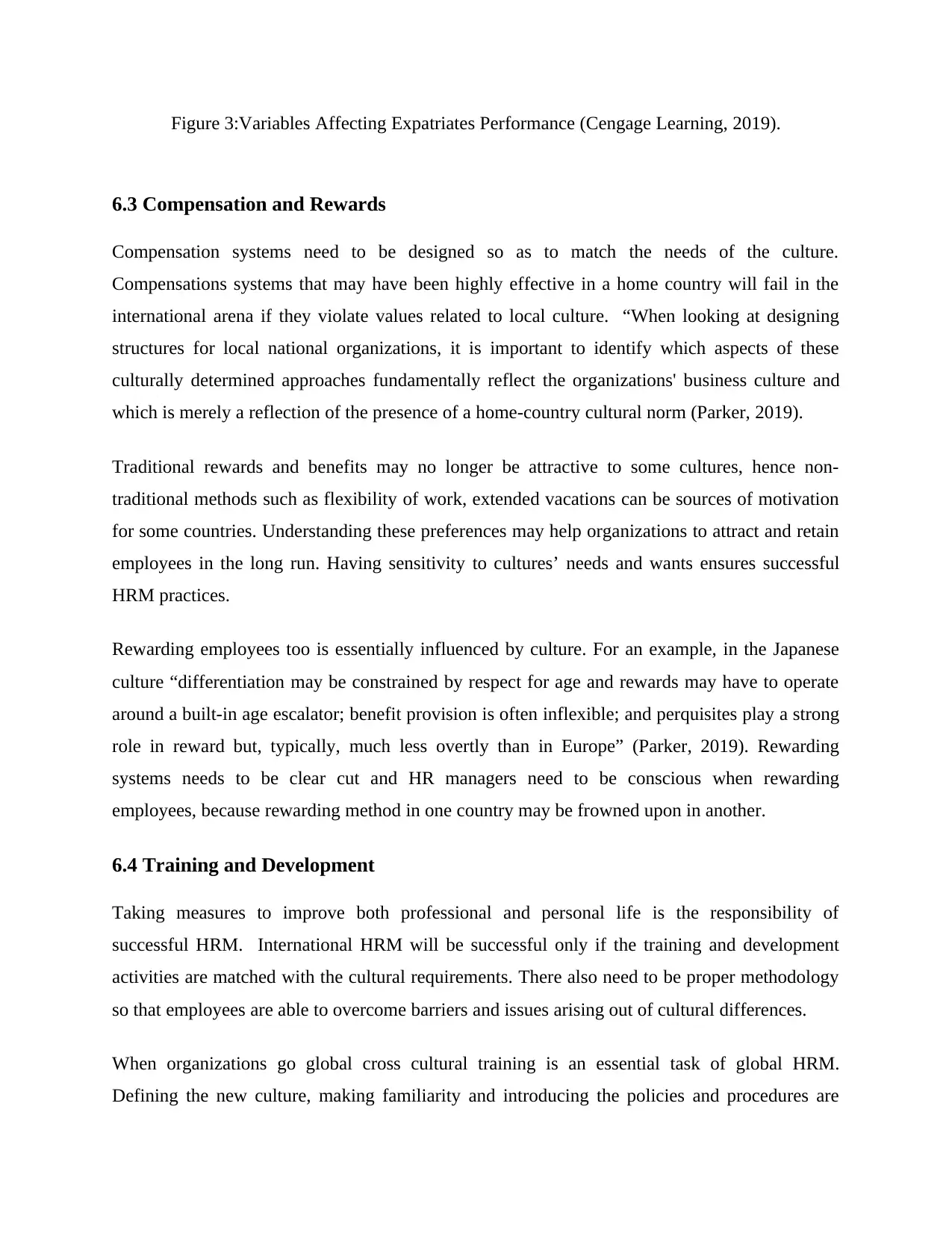
Figure 3:Variables Affecting Expatriates Performance (Cengage Learning, 2019).
6.3 Compensation and Rewards
Compensation systems need to be designed so as to match the needs of the culture.
Compensations systems that may have been highly effective in a home country will fail in the
international arena if they violate values related to local culture. “When looking at designing
structures for local national organizations, it is important to identify which aspects of these
culturally determined approaches fundamentally reflect the organizations' business culture and
which is merely a reflection of the presence of a home-country cultural norm (Parker, 2019).
Traditional rewards and benefits may no longer be attractive to some cultures, hence non-
traditional methods such as flexibility of work, extended vacations can be sources of motivation
for some countries. Understanding these preferences may help organizations to attract and retain
employees in the long run. Having sensitivity to cultures’ needs and wants ensures successful
HRM practices.
Rewarding employees too is essentially influenced by culture. For an example, in the Japanese
culture “differentiation may be constrained by respect for age and rewards may have to operate
around a built-in age escalator; benefit provision is often inflexible; and perquisites play a strong
role in reward but, typically, much less overtly than in Europe” (Parker, 2019). Rewarding
systems needs to be clear cut and HR managers need to be conscious when rewarding
employees, because rewarding method in one country may be frowned upon in another.
6.4 Training and Development
Taking measures to improve both professional and personal life is the responsibility of
successful HRM. International HRM will be successful only if the training and development
activities are matched with the cultural requirements. There also need to be proper methodology
so that employees are able to overcome barriers and issues arising out of cultural differences.
When organizations go global cross cultural training is an essential task of global HRM.
Defining the new culture, making familiarity and introducing the policies and procedures are
6.3 Compensation and Rewards
Compensation systems need to be designed so as to match the needs of the culture.
Compensations systems that may have been highly effective in a home country will fail in the
international arena if they violate values related to local culture. “When looking at designing
structures for local national organizations, it is important to identify which aspects of these
culturally determined approaches fundamentally reflect the organizations' business culture and
which is merely a reflection of the presence of a home-country cultural norm (Parker, 2019).
Traditional rewards and benefits may no longer be attractive to some cultures, hence non-
traditional methods such as flexibility of work, extended vacations can be sources of motivation
for some countries. Understanding these preferences may help organizations to attract and retain
employees in the long run. Having sensitivity to cultures’ needs and wants ensures successful
HRM practices.
Rewarding employees too is essentially influenced by culture. For an example, in the Japanese
culture “differentiation may be constrained by respect for age and rewards may have to operate
around a built-in age escalator; benefit provision is often inflexible; and perquisites play a strong
role in reward but, typically, much less overtly than in Europe” (Parker, 2019). Rewarding
systems needs to be clear cut and HR managers need to be conscious when rewarding
employees, because rewarding method in one country may be frowned upon in another.
6.4 Training and Development
Taking measures to improve both professional and personal life is the responsibility of
successful HRM. International HRM will be successful only if the training and development
activities are matched with the cultural requirements. There also need to be proper methodology
so that employees are able to overcome barriers and issues arising out of cultural differences.
When organizations go global cross cultural training is an essential task of global HRM.
Defining the new culture, making familiarity and introducing the policies and procedures are
Secure Best Marks with AI Grader
Need help grading? Try our AI Grader for instant feedback on your assignments.
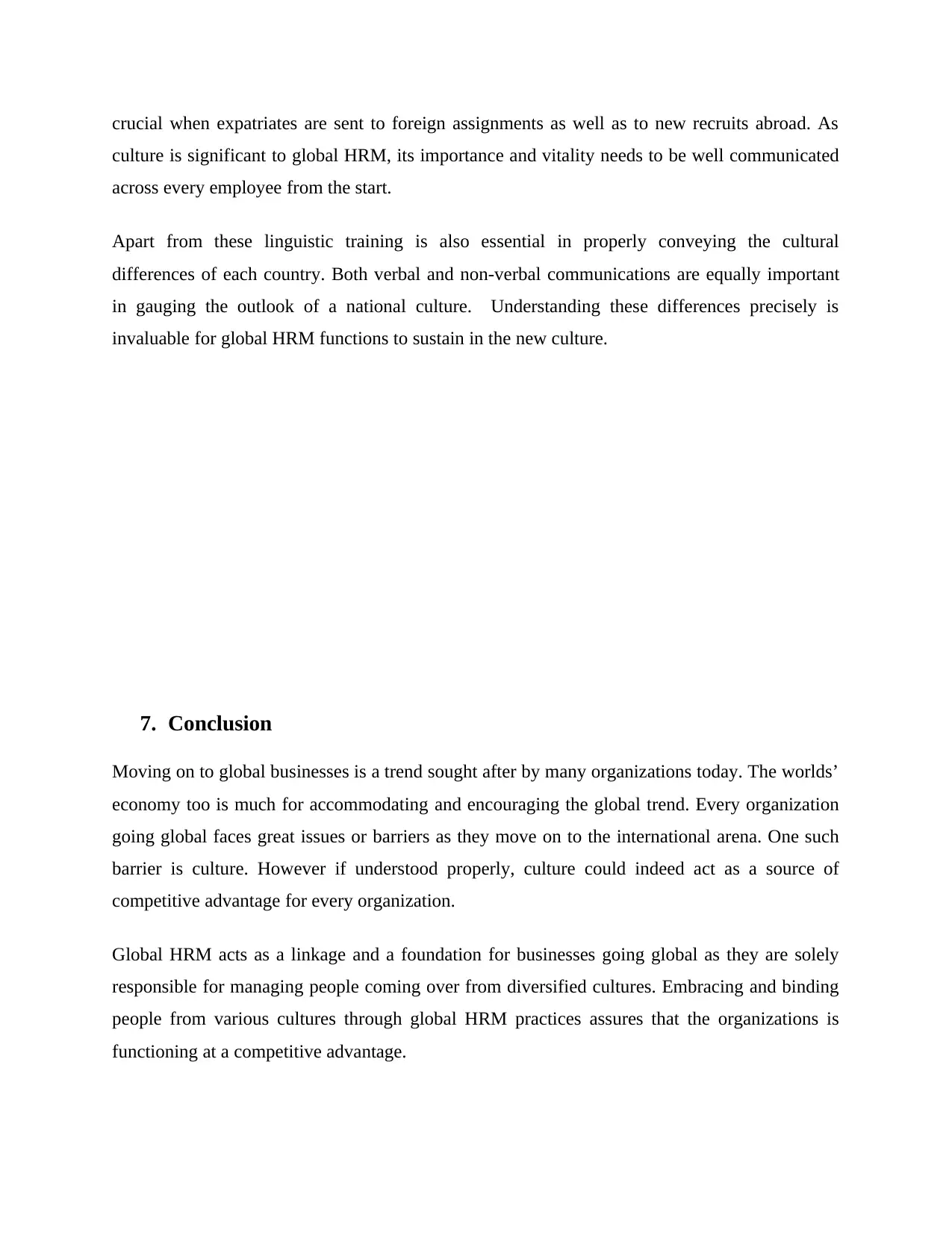
crucial when expatriates are sent to foreign assignments as well as to new recruits abroad. As
culture is significant to global HRM, its importance and vitality needs to be well communicated
across every employee from the start.
Apart from these linguistic training is also essential in properly conveying the cultural
differences of each country. Both verbal and non-verbal communications are equally important
in gauging the outlook of a national culture. Understanding these differences precisely is
invaluable for global HRM functions to sustain in the new culture.
7. Conclusion
Moving on to global businesses is a trend sought after by many organizations today. The worlds’
economy too is much for accommodating and encouraging the global trend. Every organization
going global faces great issues or barriers as they move on to the international arena. One such
barrier is culture. However if understood properly, culture could indeed act as a source of
competitive advantage for every organization.
Global HRM acts as a linkage and a foundation for businesses going global as they are solely
responsible for managing people coming over from diversified cultures. Embracing and binding
people from various cultures through global HRM practices assures that the organizations is
functioning at a competitive advantage.
culture is significant to global HRM, its importance and vitality needs to be well communicated
across every employee from the start.
Apart from these linguistic training is also essential in properly conveying the cultural
differences of each country. Both verbal and non-verbal communications are equally important
in gauging the outlook of a national culture. Understanding these differences precisely is
invaluable for global HRM functions to sustain in the new culture.
7. Conclusion
Moving on to global businesses is a trend sought after by many organizations today. The worlds’
economy too is much for accommodating and encouraging the global trend. Every organization
going global faces great issues or barriers as they move on to the international arena. One such
barrier is culture. However if understood properly, culture could indeed act as a source of
competitive advantage for every organization.
Global HRM acts as a linkage and a foundation for businesses going global as they are solely
responsible for managing people coming over from diversified cultures. Embracing and binding
people from various cultures through global HRM practices assures that the organizations is
functioning at a competitive advantage.
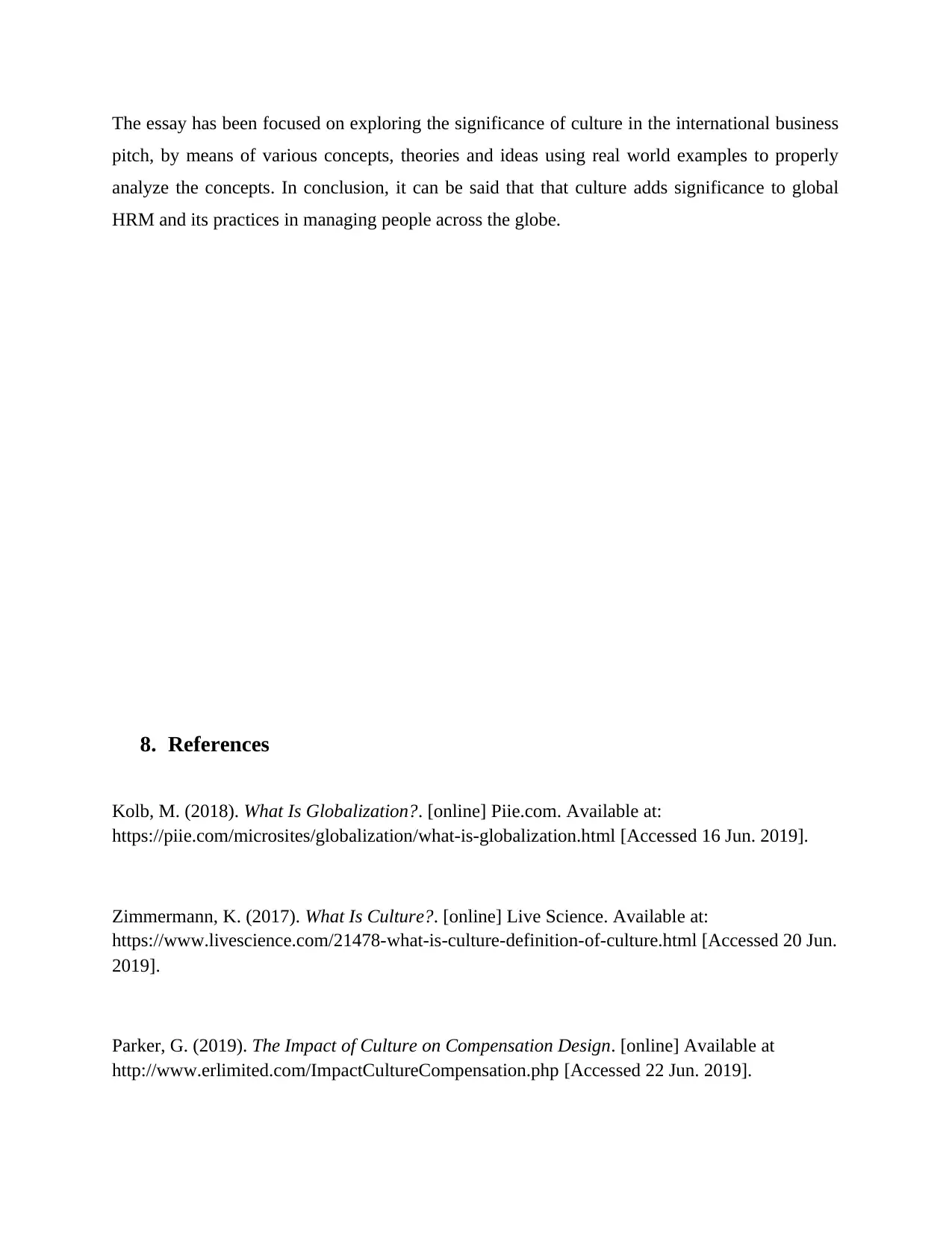
The essay has been focused on exploring the significance of culture in the international business
pitch, by means of various concepts, theories and ideas using real world examples to properly
analyze the concepts. In conclusion, it can be said that that culture adds significance to global
HRM and its practices in managing people across the globe.
8. References
Kolb, M. (2018). What Is Globalization?. [online] Piie.com. Available at:
https://piie.com/microsites/globalization/what-is-globalization.html [Accessed 16 Jun. 2019].
Zimmermann, K. (2017). What Is Culture?. [online] Live Science. Available at:
https://www.livescience.com/21478-what-is-culture-definition-of-culture.html [Accessed 20 Jun.
2019].
Parker, G. (2019). The Impact of Culture on Compensation Design. [online] Available at
http://www.erlimited.com/ImpactCultureCompensation.php [Accessed 22 Jun. 2019].
pitch, by means of various concepts, theories and ideas using real world examples to properly
analyze the concepts. In conclusion, it can be said that that culture adds significance to global
HRM and its practices in managing people across the globe.
8. References
Kolb, M. (2018). What Is Globalization?. [online] Piie.com. Available at:
https://piie.com/microsites/globalization/what-is-globalization.html [Accessed 16 Jun. 2019].
Zimmermann, K. (2017). What Is Culture?. [online] Live Science. Available at:
https://www.livescience.com/21478-what-is-culture-definition-of-culture.html [Accessed 20 Jun.
2019].
Parker, G. (2019). The Impact of Culture on Compensation Design. [online] Available at
http://www.erlimited.com/ImpactCultureCompensation.php [Accessed 22 Jun. 2019].
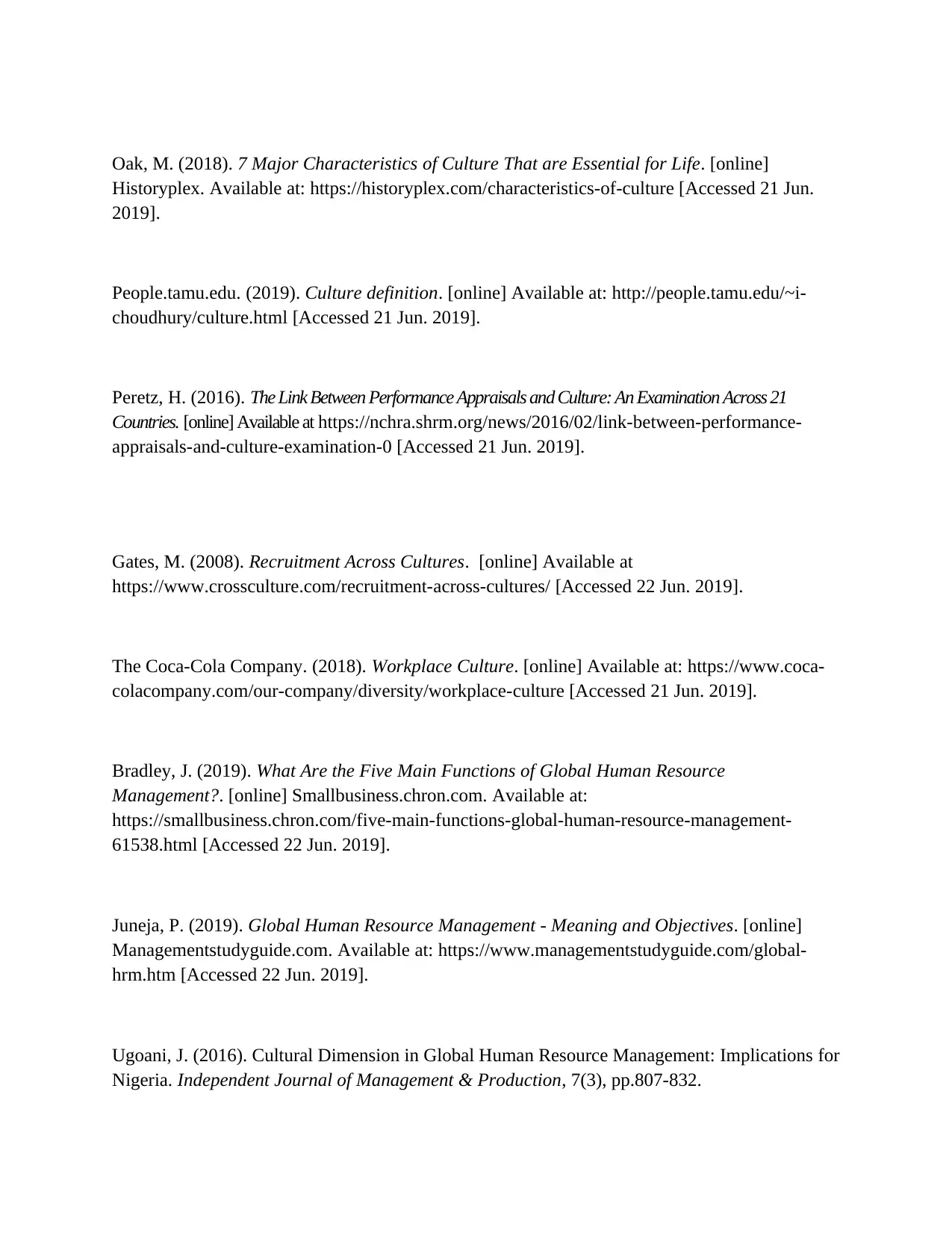
Oak, M. (2018). 7 Major Characteristics of Culture That are Essential for Life. [online]
Historyplex. Available at: https://historyplex.com/characteristics-of-culture [Accessed 21 Jun.
2019].
People.tamu.edu. (2019). Culture definition. [online] Available at: http://people.tamu.edu/~i-
choudhury/culture.html [Accessed 21 Jun. 2019].
Peretz, H. (2016). The Link Between Performance Appraisals and Culture: An Examination Across 21
Countries. [online] Available at https://nchra.shrm.org/news/2016/02/link-between-performance-
appraisals-and-culture-examination-0 [Accessed 21 Jun. 2019].
Gates, M. (2008). Recruitment Across Cultures. [online] Available at
https://www.crossculture.com/recruitment-across-cultures/ [Accessed 22 Jun. 2019].
The Coca-Cola Company. (2018). Workplace Culture. [online] Available at: https://www.coca-
colacompany.com/our-company/diversity/workplace-culture [Accessed 21 Jun. 2019].
Bradley, J. (2019). What Are the Five Main Functions of Global Human Resource
Management?. [online] Smallbusiness.chron.com. Available at:
https://smallbusiness.chron.com/five-main-functions-global-human-resource-management-
61538.html [Accessed 22 Jun. 2019].
Juneja, P. (2019). Global Human Resource Management - Meaning and Objectives. [online]
Managementstudyguide.com. Available at: https://www.managementstudyguide.com/global-
hrm.htm [Accessed 22 Jun. 2019].
Ugoani, J. (2016). Cultural Dimension in Global Human Resource Management: Implications for
Nigeria. Independent Journal of Management & Production, 7(3), pp.807-832.
Historyplex. Available at: https://historyplex.com/characteristics-of-culture [Accessed 21 Jun.
2019].
People.tamu.edu. (2019). Culture definition. [online] Available at: http://people.tamu.edu/~i-
choudhury/culture.html [Accessed 21 Jun. 2019].
Peretz, H. (2016). The Link Between Performance Appraisals and Culture: An Examination Across 21
Countries. [online] Available at https://nchra.shrm.org/news/2016/02/link-between-performance-
appraisals-and-culture-examination-0 [Accessed 21 Jun. 2019].
Gates, M. (2008). Recruitment Across Cultures. [online] Available at
https://www.crossculture.com/recruitment-across-cultures/ [Accessed 22 Jun. 2019].
The Coca-Cola Company. (2018). Workplace Culture. [online] Available at: https://www.coca-
colacompany.com/our-company/diversity/workplace-culture [Accessed 21 Jun. 2019].
Bradley, J. (2019). What Are the Five Main Functions of Global Human Resource
Management?. [online] Smallbusiness.chron.com. Available at:
https://smallbusiness.chron.com/five-main-functions-global-human-resource-management-
61538.html [Accessed 22 Jun. 2019].
Juneja, P. (2019). Global Human Resource Management - Meaning and Objectives. [online]
Managementstudyguide.com. Available at: https://www.managementstudyguide.com/global-
hrm.htm [Accessed 22 Jun. 2019].
Ugoani, J. (2016). Cultural Dimension in Global Human Resource Management: Implications for
Nigeria. Independent Journal of Management & Production, 7(3), pp.807-832.
Paraphrase This Document
Need a fresh take? Get an instant paraphrase of this document with our AI Paraphraser
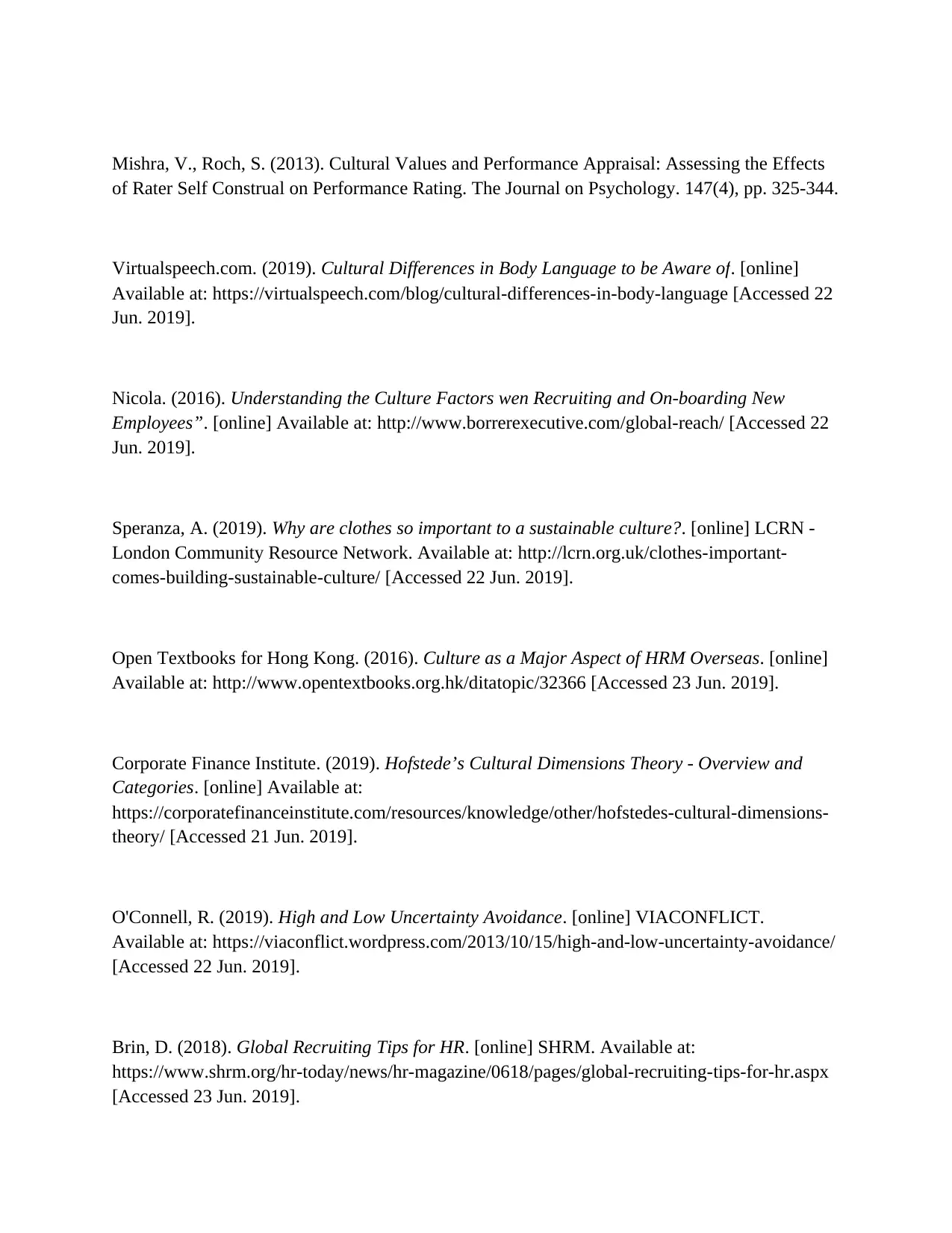
Mishra, V., Roch, S. (2013). Cultural Values and Performance Appraisal: Assessing the Effects
of Rater Self Construal on Performance Rating. The Journal on Psychology. 147(4), pp. 325-344.
Virtualspeech.com. (2019). Cultural Differences in Body Language to be Aware of. [online]
Available at: https://virtualspeech.com/blog/cultural-differences-in-body-language [Accessed 22
Jun. 2019].
Nicola. (2016). Understanding the Culture Factors wen Recruiting and On-boarding New
Employees”. [online] Available at: http://www.borrerexecutive.com/global-reach/ [Accessed 22
Jun. 2019].
Speranza, A. (2019). Why are clothes so important to a sustainable culture?. [online] LCRN -
London Community Resource Network. Available at: http://lcrn.org.uk/clothes-important-
comes-building-sustainable-culture/ [Accessed 22 Jun. 2019].
Open Textbooks for Hong Kong. (2016). Culture as a Major Aspect of HRM Overseas. [online]
Available at: http://www.opentextbooks.org.hk/ditatopic/32366 [Accessed 23 Jun. 2019].
Corporate Finance Institute. (2019). Hofstede’s Cultural Dimensions Theory - Overview and
Categories. [online] Available at:
https://corporatefinanceinstitute.com/resources/knowledge/other/hofstedes-cultural-dimensions-
theory/ [Accessed 21 Jun. 2019].
O'Connell, R. (2019). High and Low Uncertainty Avoidance. [online] VIACONFLICT.
Available at: https://viaconflict.wordpress.com/2013/10/15/high-and-low-uncertainty-avoidance/
[Accessed 22 Jun. 2019].
Brin, D. (2018). Global Recruiting Tips for HR. [online] SHRM. Available at:
https://www.shrm.org/hr-today/news/hr-magazine/0618/pages/global-recruiting-tips-for-hr.aspx
[Accessed 23 Jun. 2019].
of Rater Self Construal on Performance Rating. The Journal on Psychology. 147(4), pp. 325-344.
Virtualspeech.com. (2019). Cultural Differences in Body Language to be Aware of. [online]
Available at: https://virtualspeech.com/blog/cultural-differences-in-body-language [Accessed 22
Jun. 2019].
Nicola. (2016). Understanding the Culture Factors wen Recruiting and On-boarding New
Employees”. [online] Available at: http://www.borrerexecutive.com/global-reach/ [Accessed 22
Jun. 2019].
Speranza, A. (2019). Why are clothes so important to a sustainable culture?. [online] LCRN -
London Community Resource Network. Available at: http://lcrn.org.uk/clothes-important-
comes-building-sustainable-culture/ [Accessed 22 Jun. 2019].
Open Textbooks for Hong Kong. (2016). Culture as a Major Aspect of HRM Overseas. [online]
Available at: http://www.opentextbooks.org.hk/ditatopic/32366 [Accessed 23 Jun. 2019].
Corporate Finance Institute. (2019). Hofstede’s Cultural Dimensions Theory - Overview and
Categories. [online] Available at:
https://corporatefinanceinstitute.com/resources/knowledge/other/hofstedes-cultural-dimensions-
theory/ [Accessed 21 Jun. 2019].
O'Connell, R. (2019). High and Low Uncertainty Avoidance. [online] VIACONFLICT.
Available at: https://viaconflict.wordpress.com/2013/10/15/high-and-low-uncertainty-avoidance/
[Accessed 22 Jun. 2019].
Brin, D. (2018). Global Recruiting Tips for HR. [online] SHRM. Available at:
https://www.shrm.org/hr-today/news/hr-magazine/0618/pages/global-recruiting-tips-for-hr.aspx
[Accessed 23 Jun. 2019].
1 out of 20
Related Documents
Your All-in-One AI-Powered Toolkit for Academic Success.
+13062052269
info@desklib.com
Available 24*7 on WhatsApp / Email
![[object Object]](/_next/static/media/star-bottom.7253800d.svg)
Unlock your academic potential
© 2024 | Zucol Services PVT LTD | All rights reserved.





